
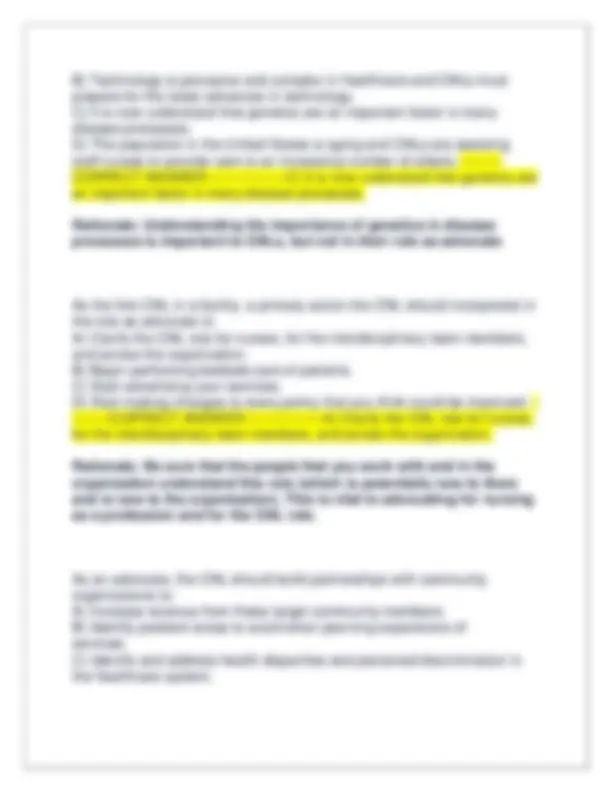
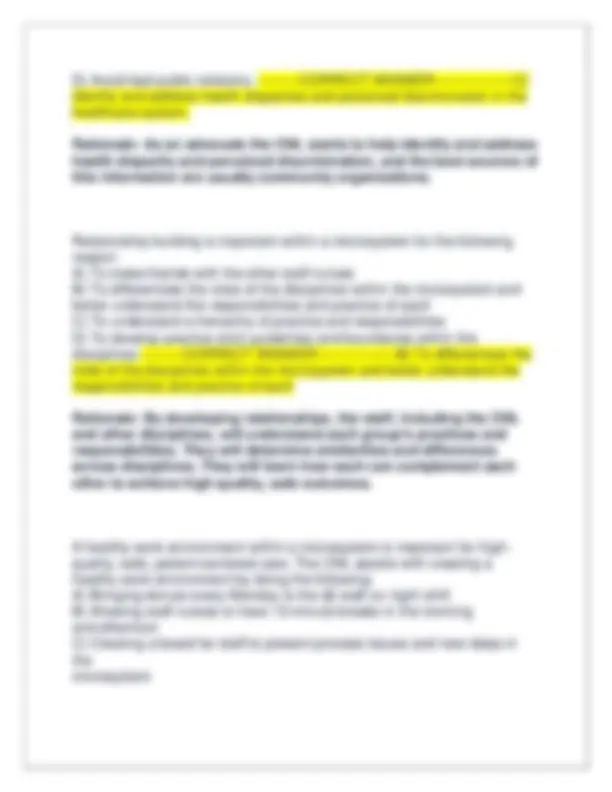
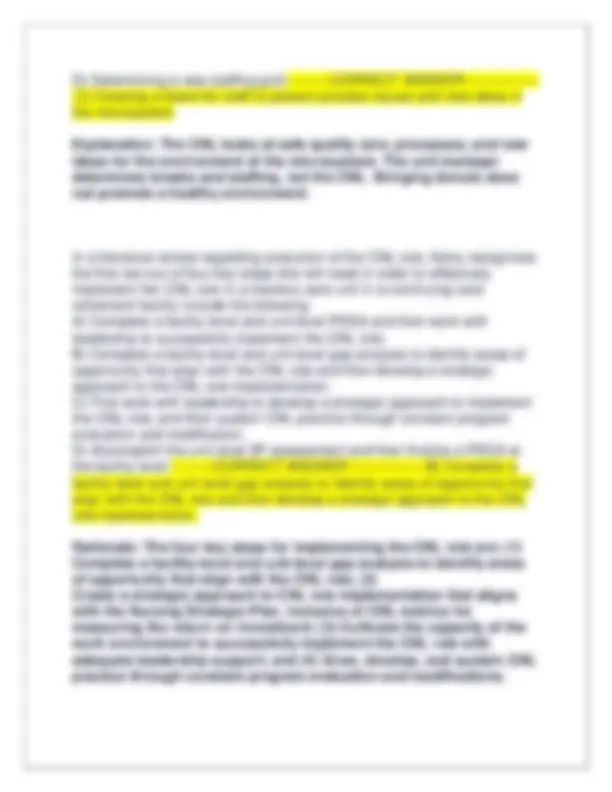
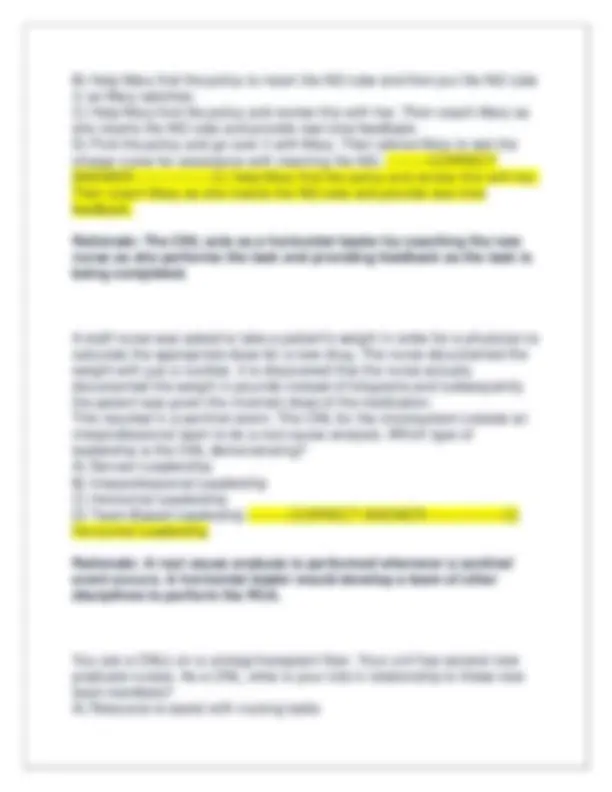
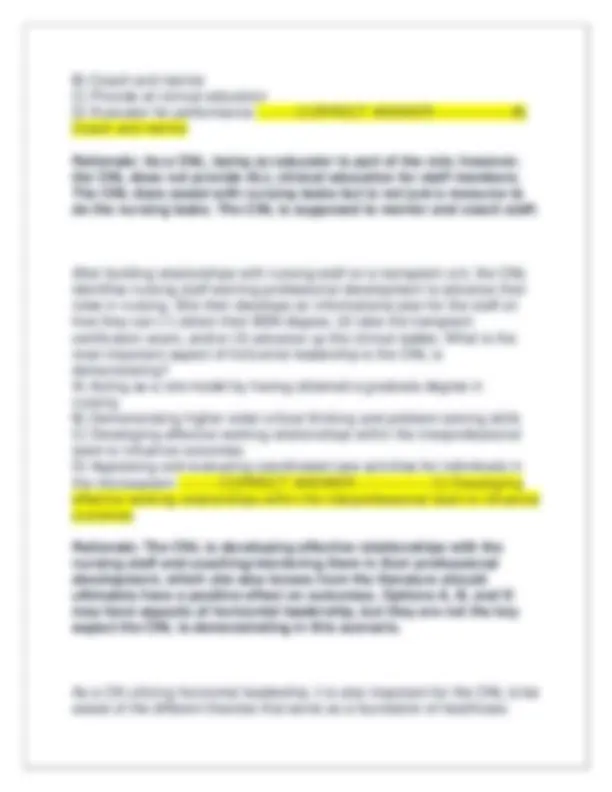
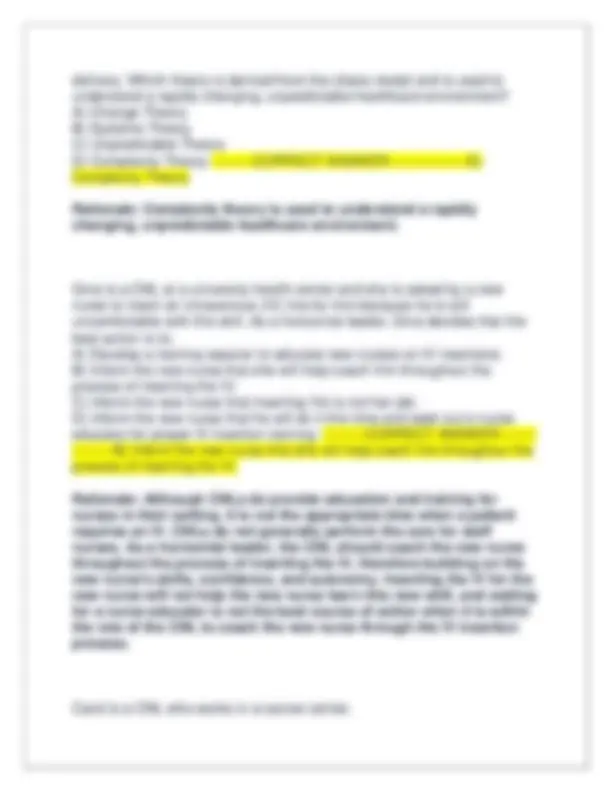
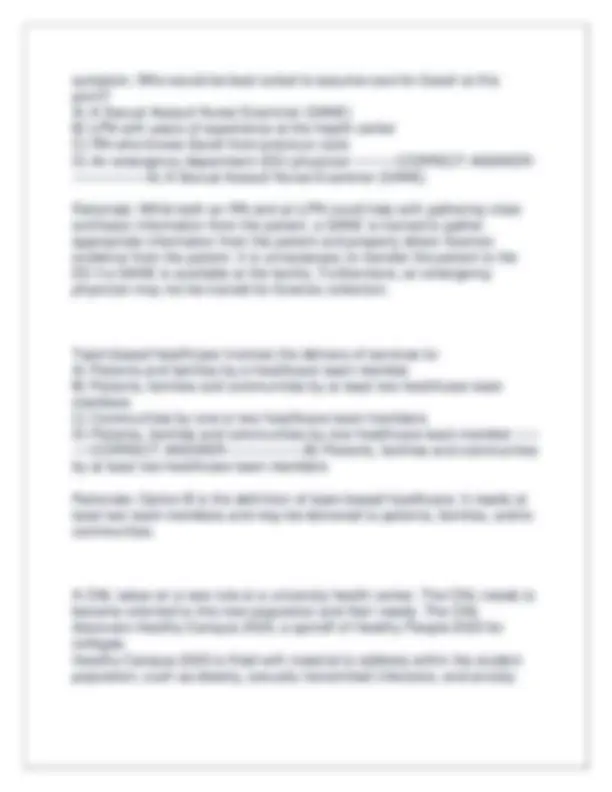
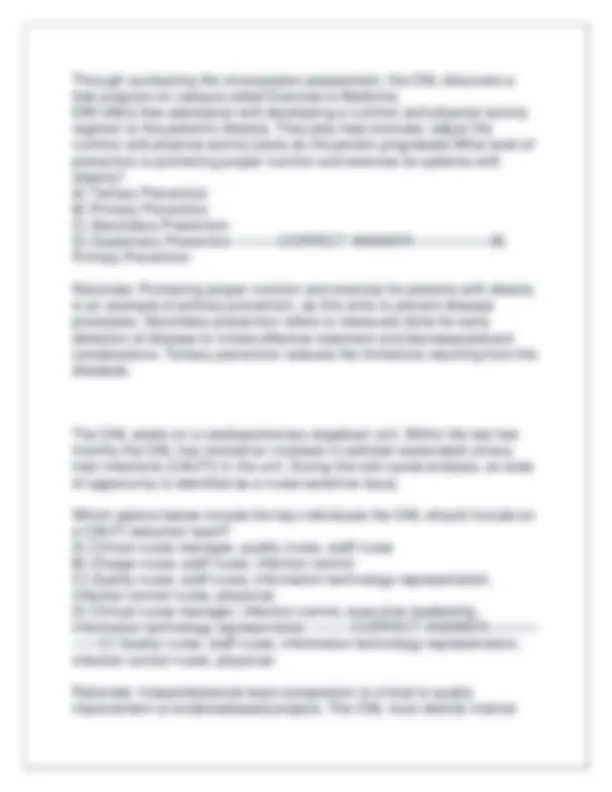
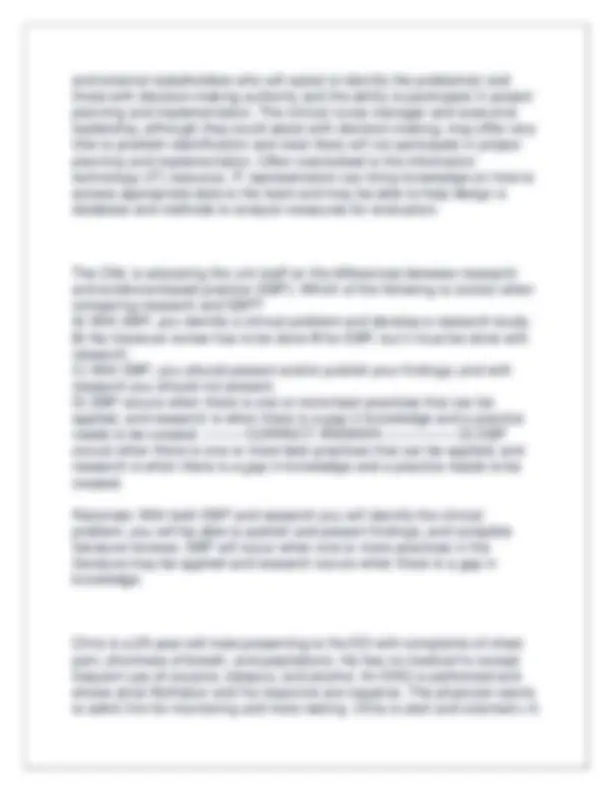
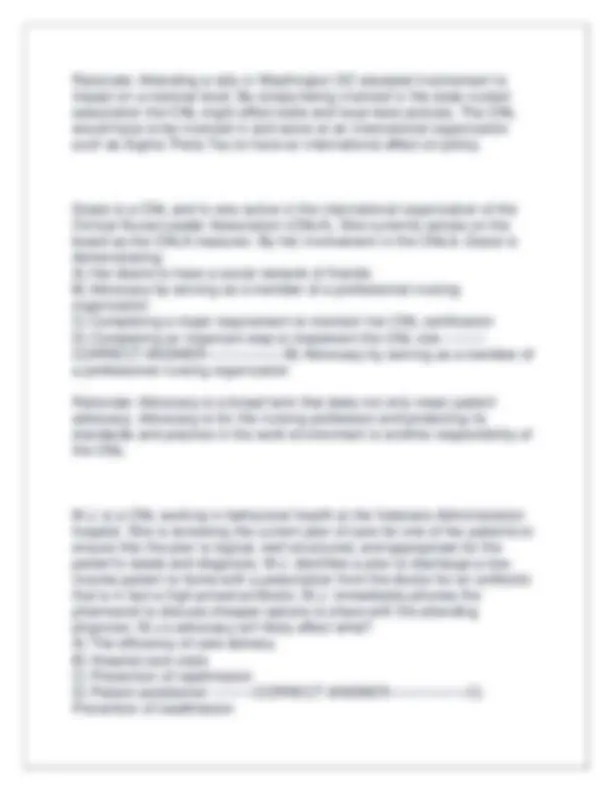
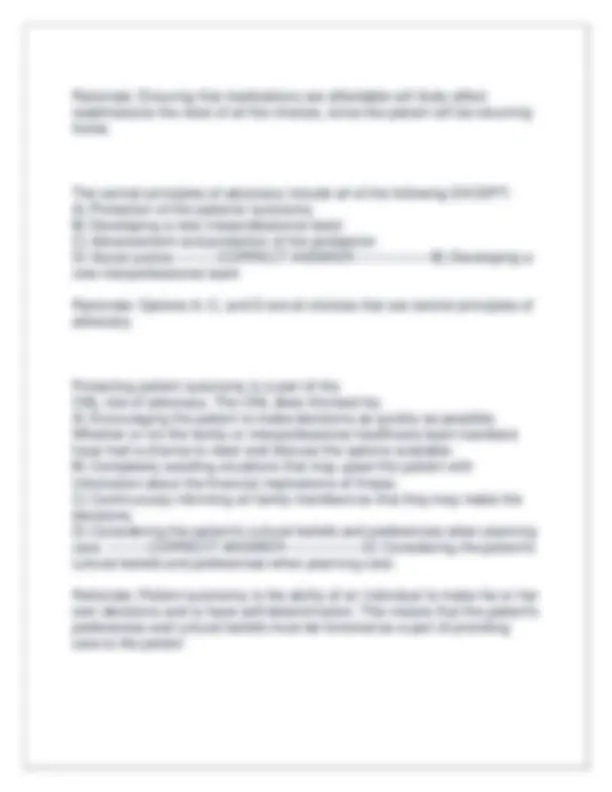

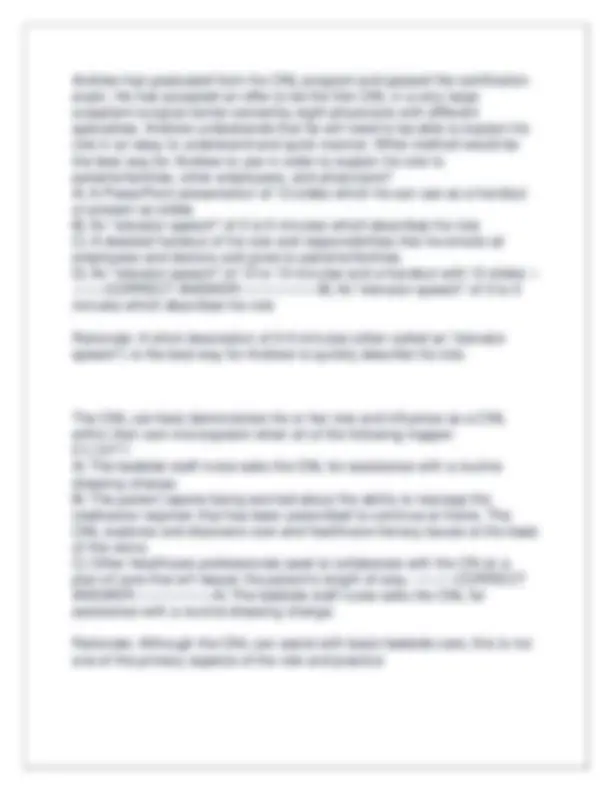
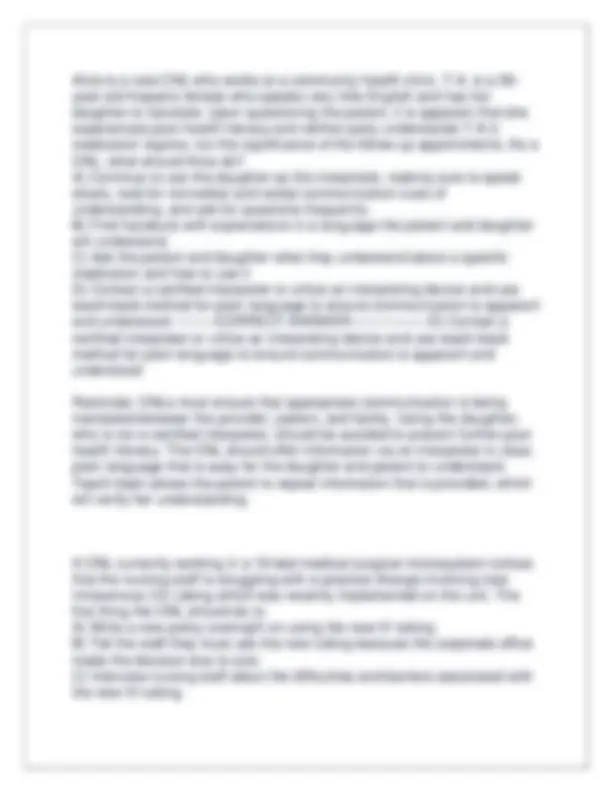

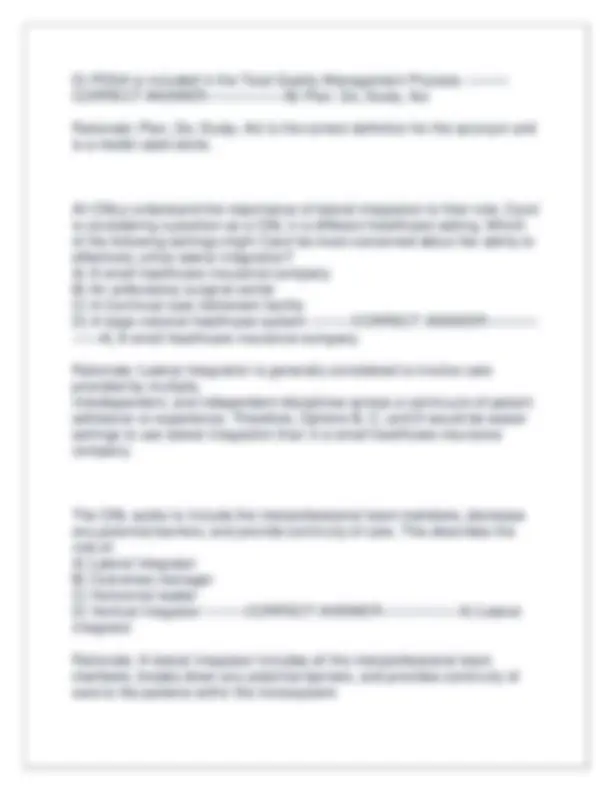
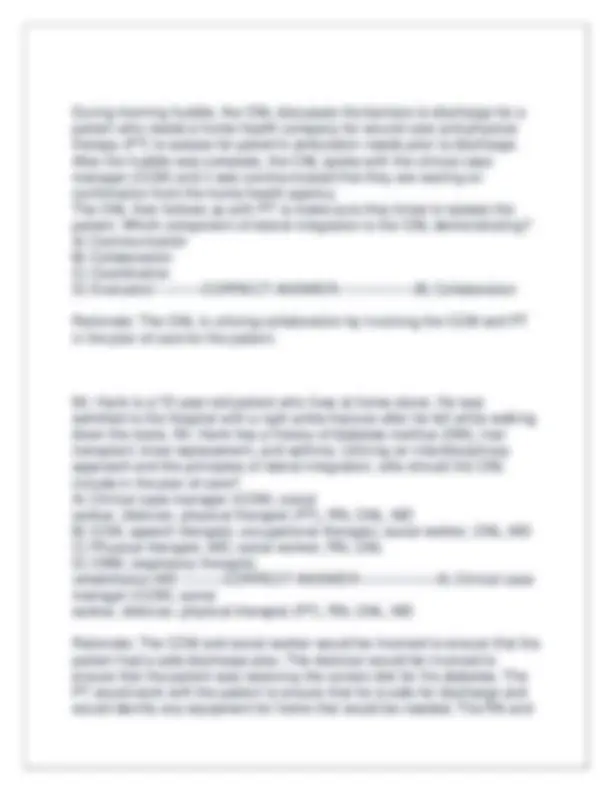
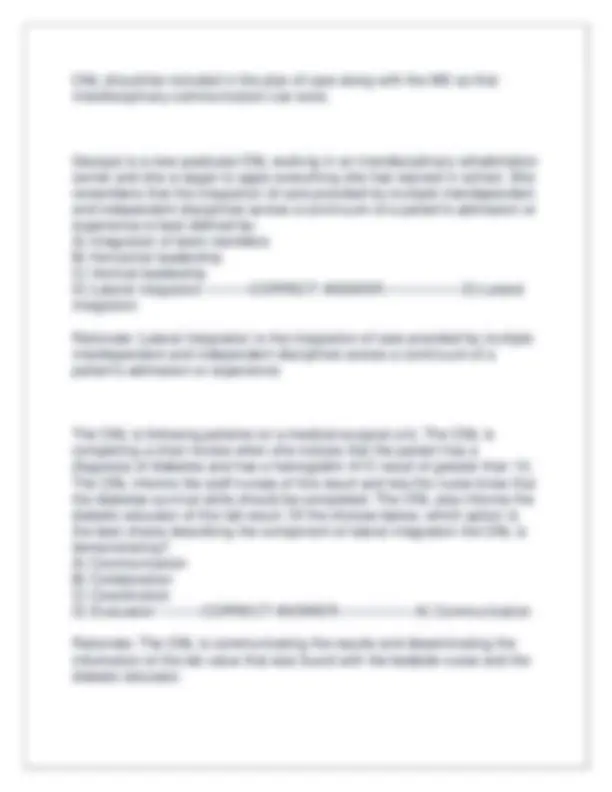
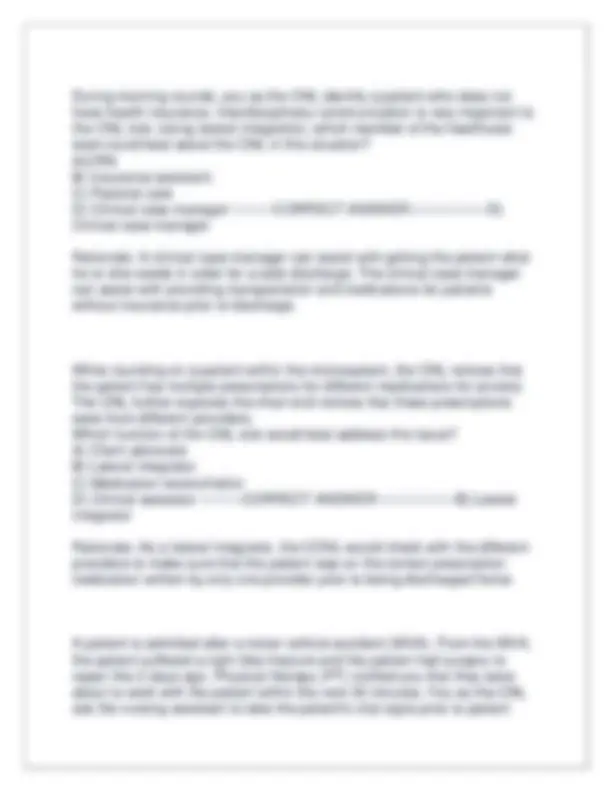
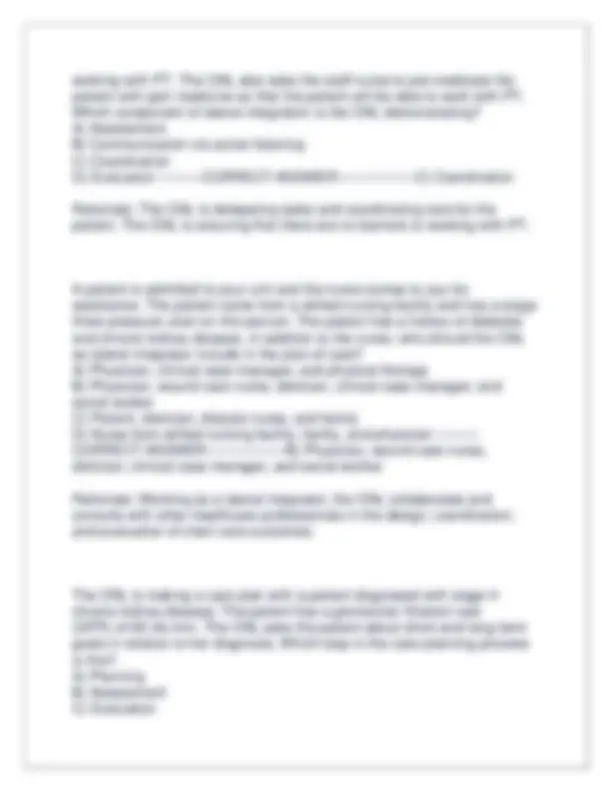
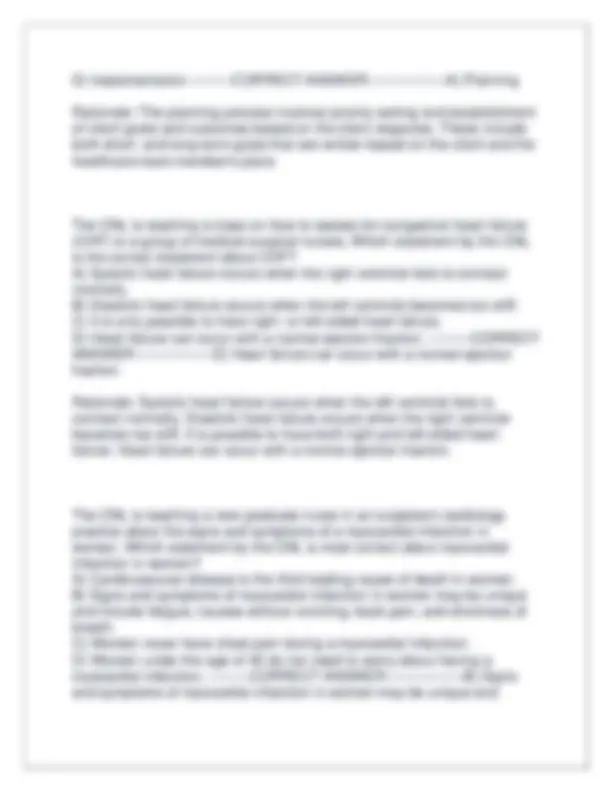
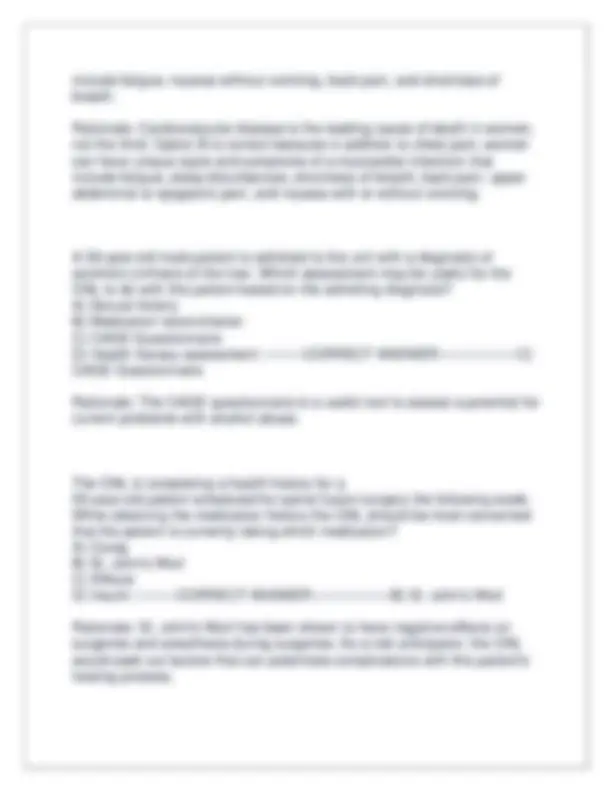
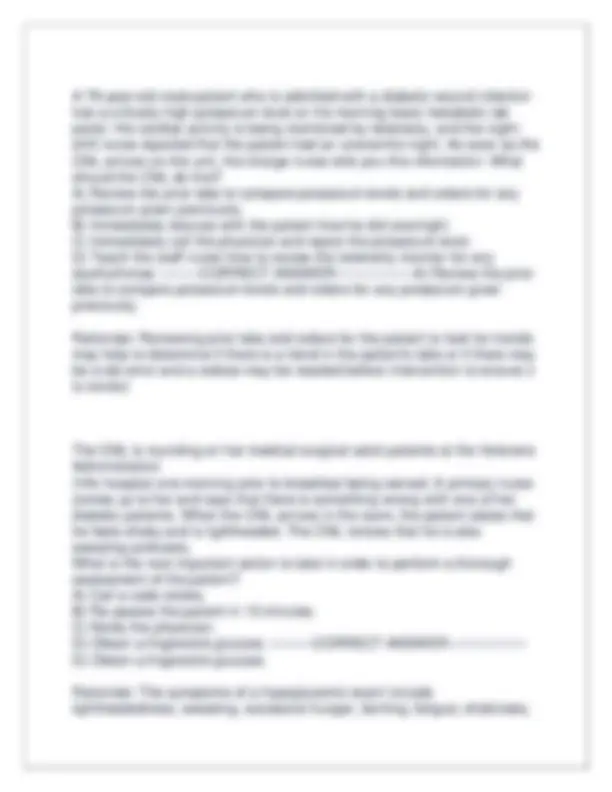
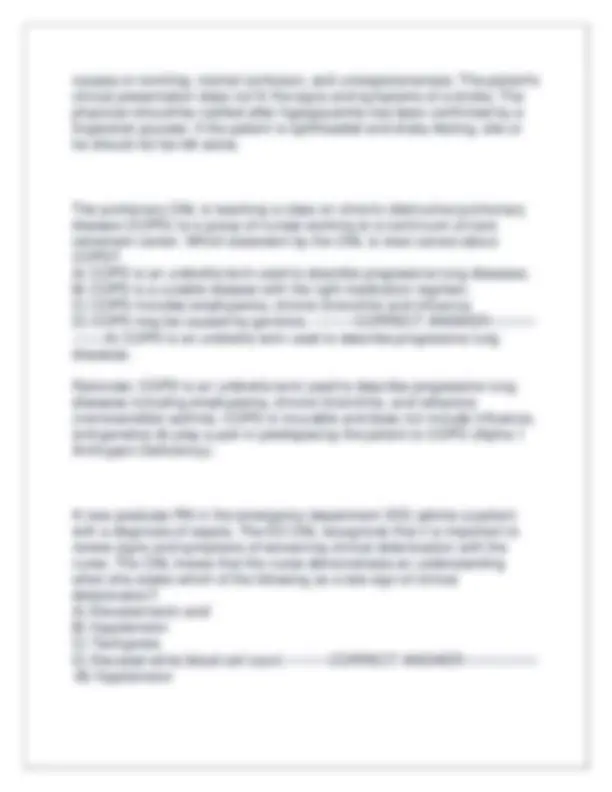
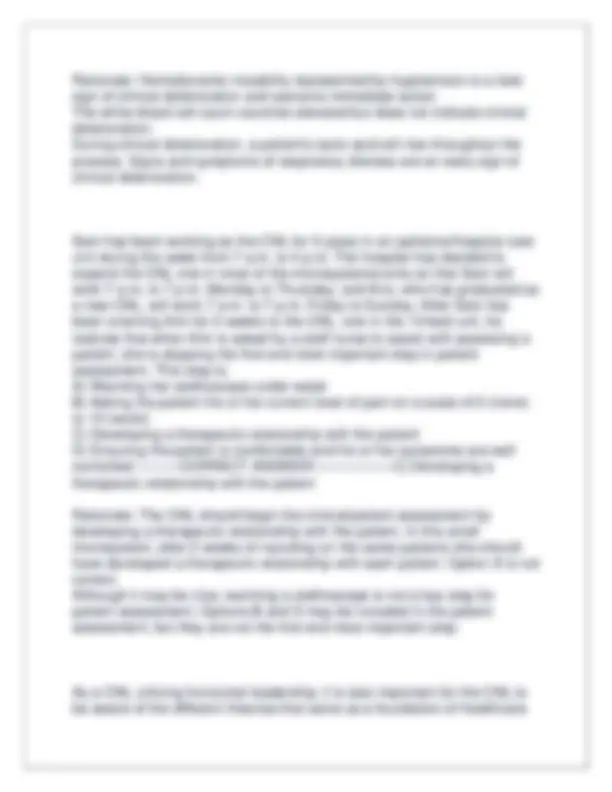
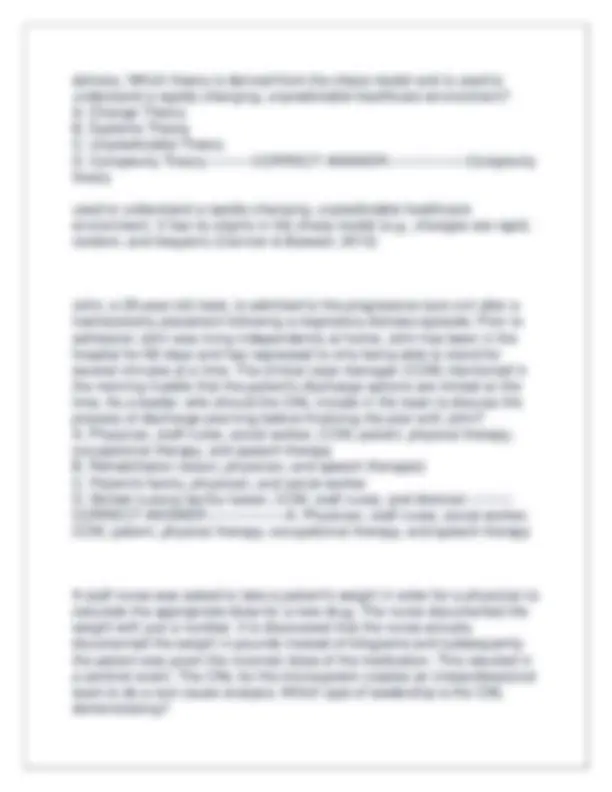
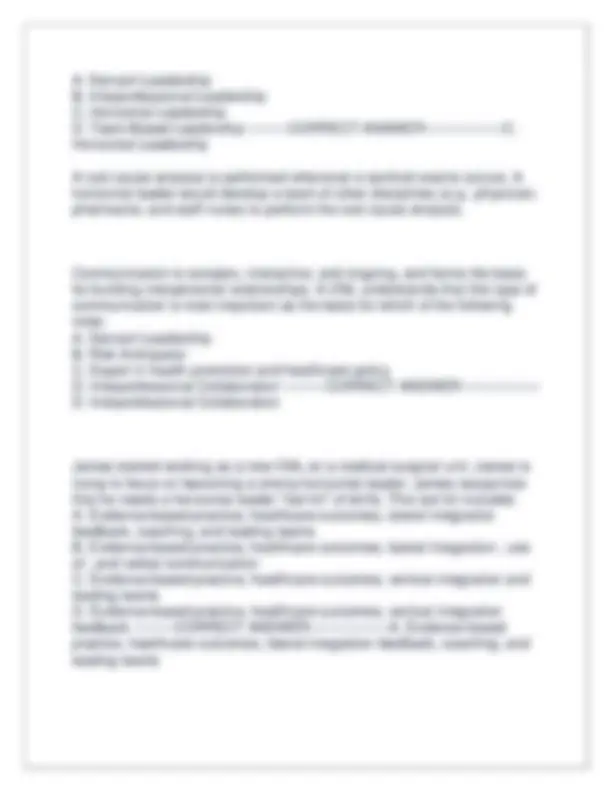
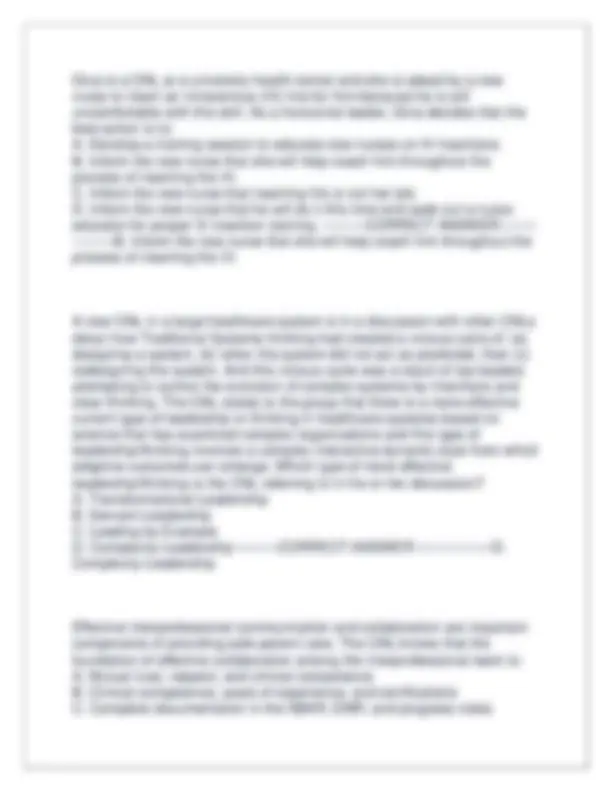
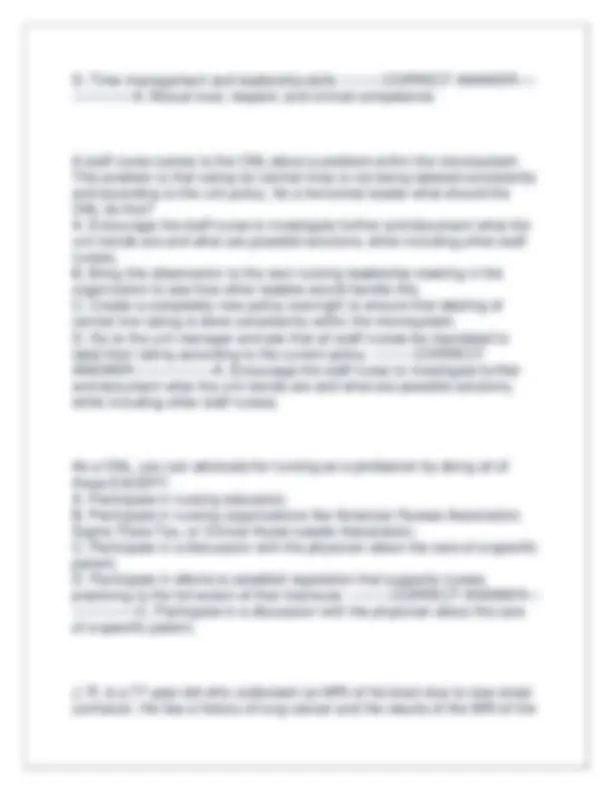
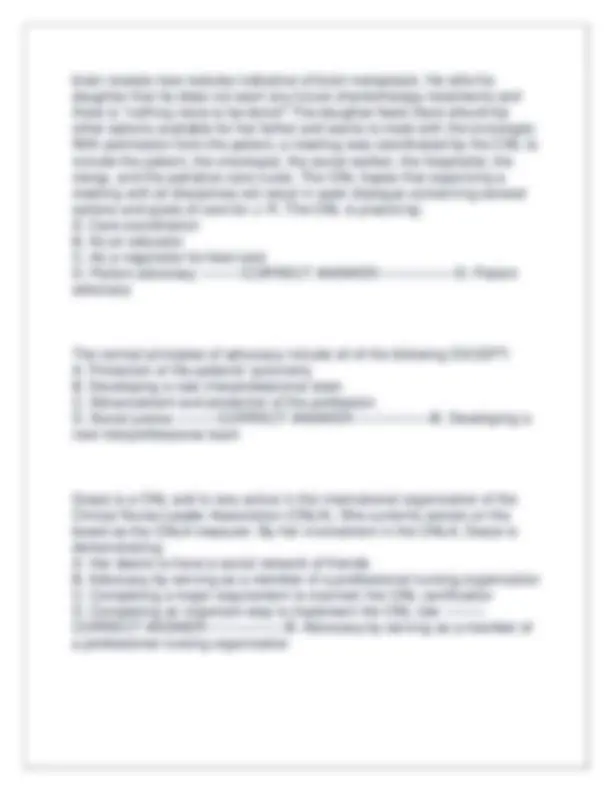
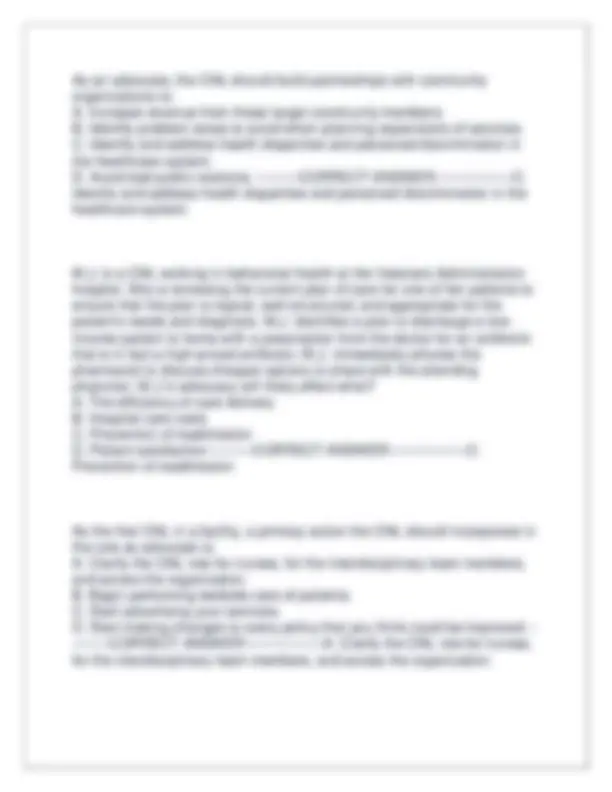
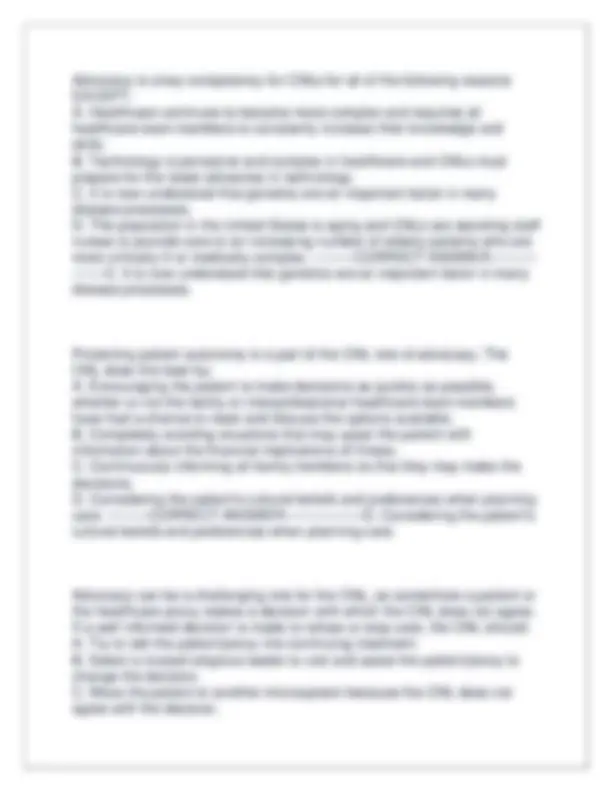
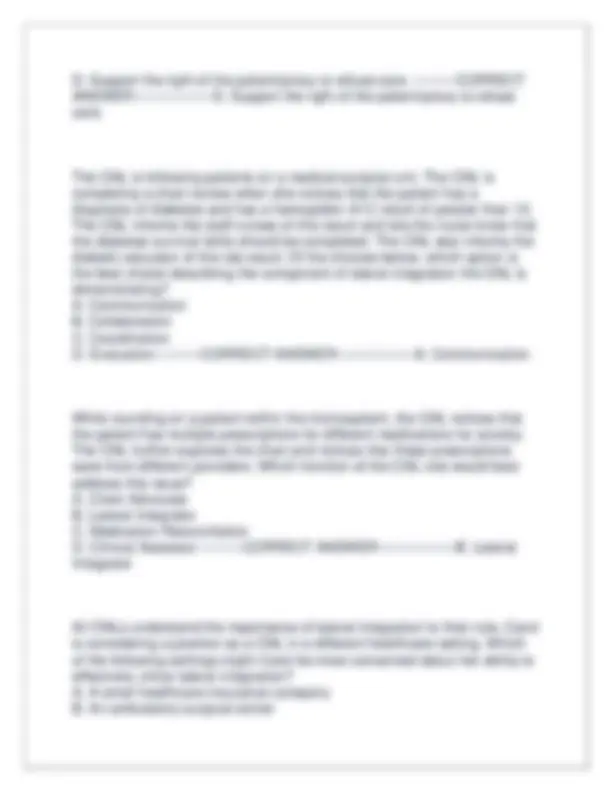
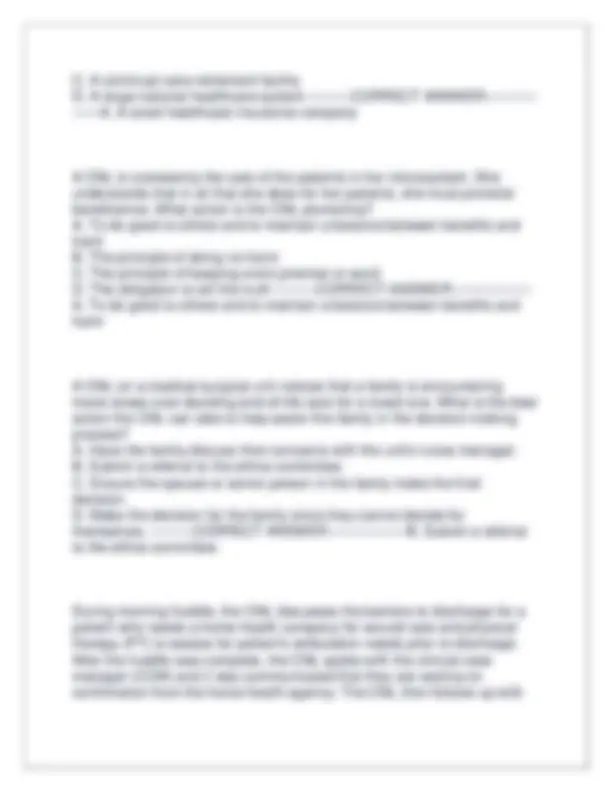
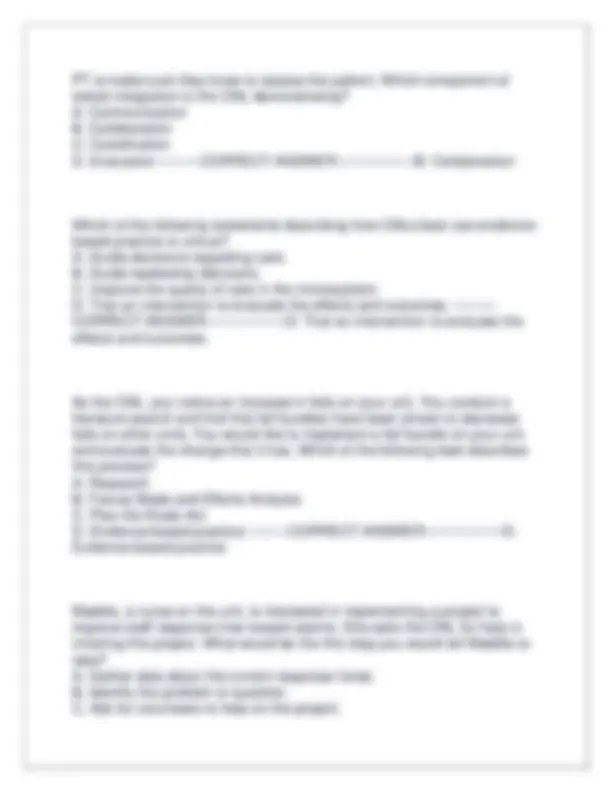
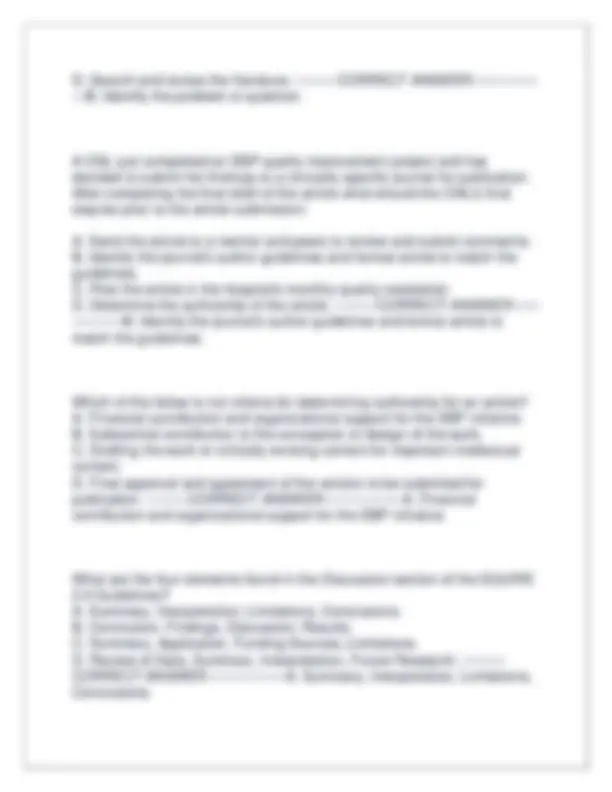
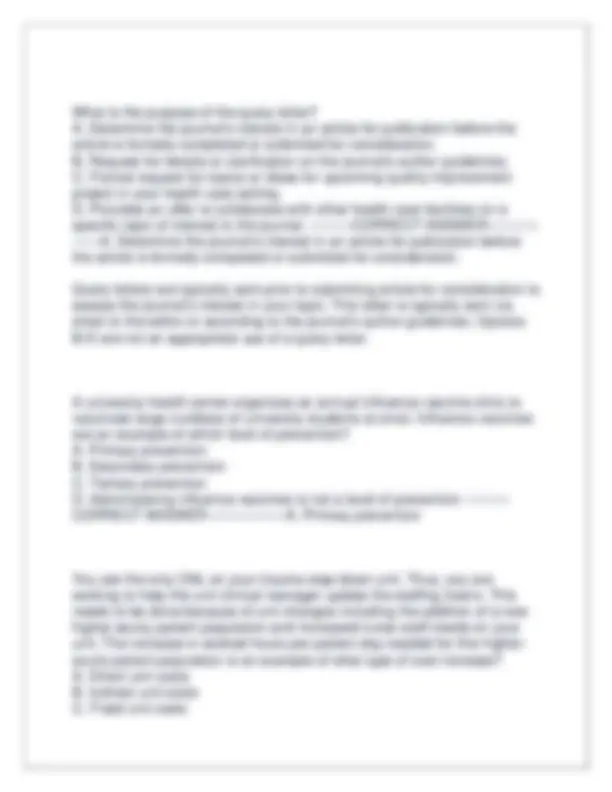
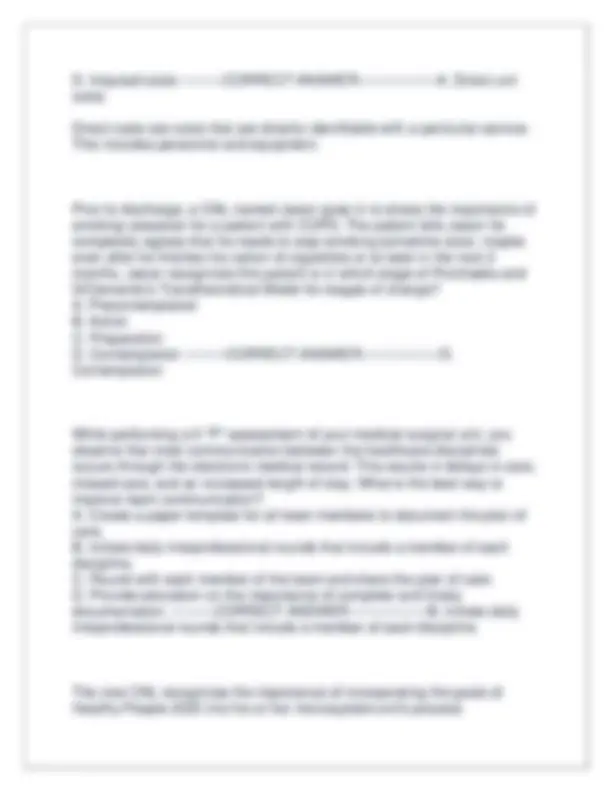
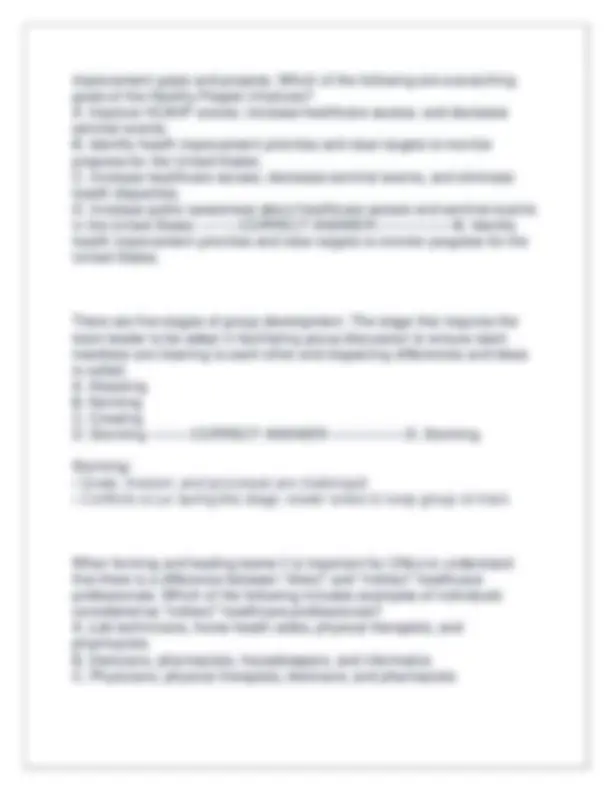
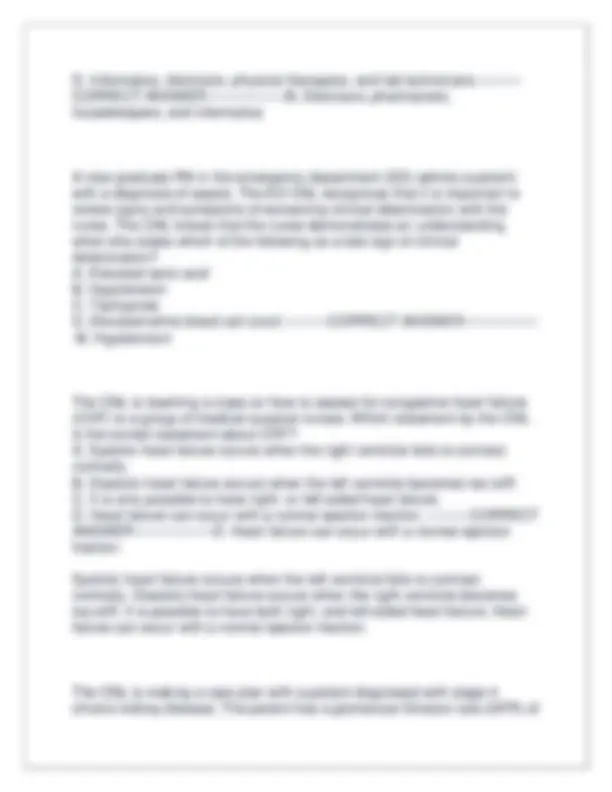
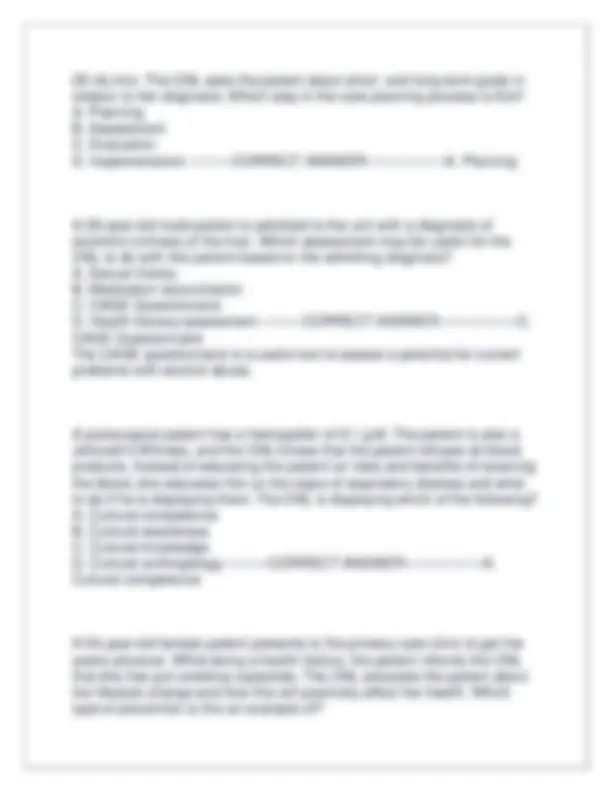

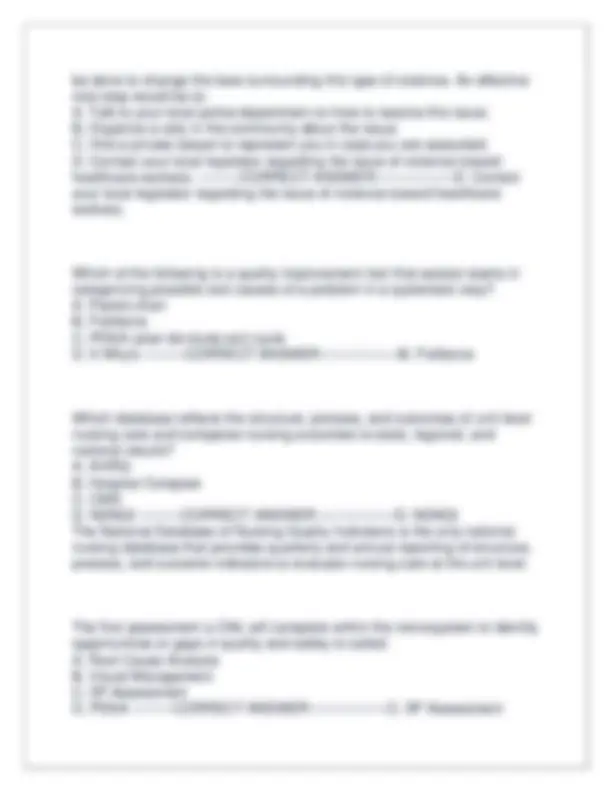
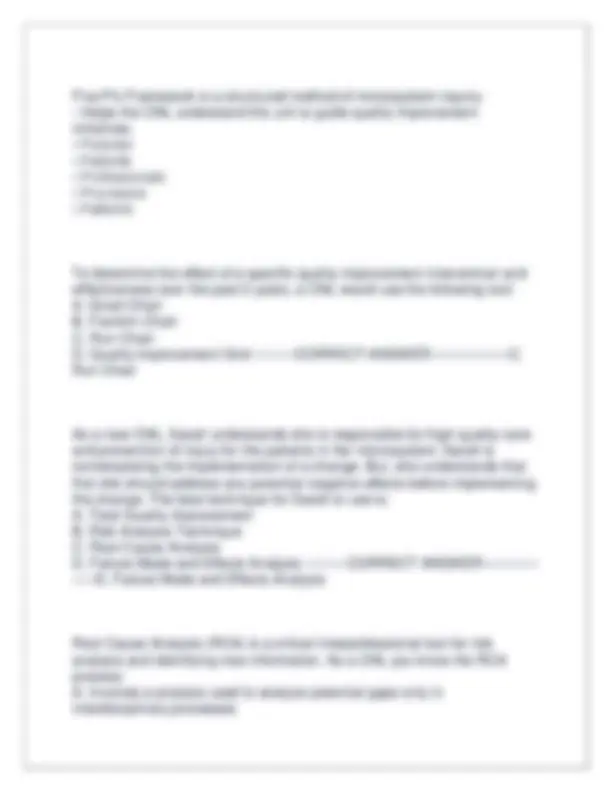
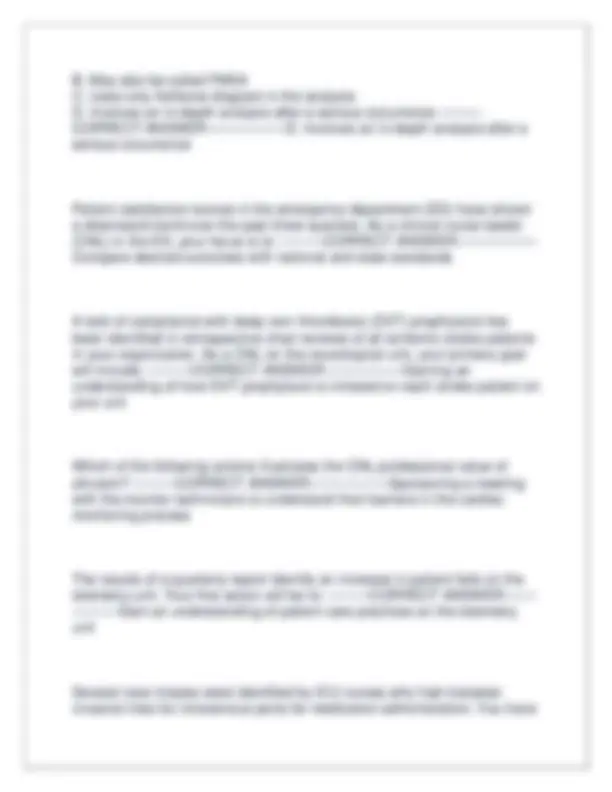
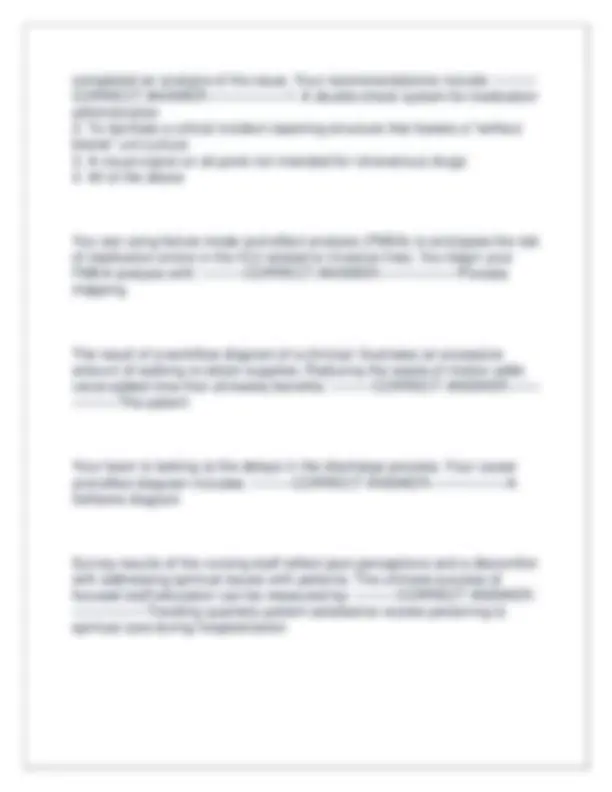
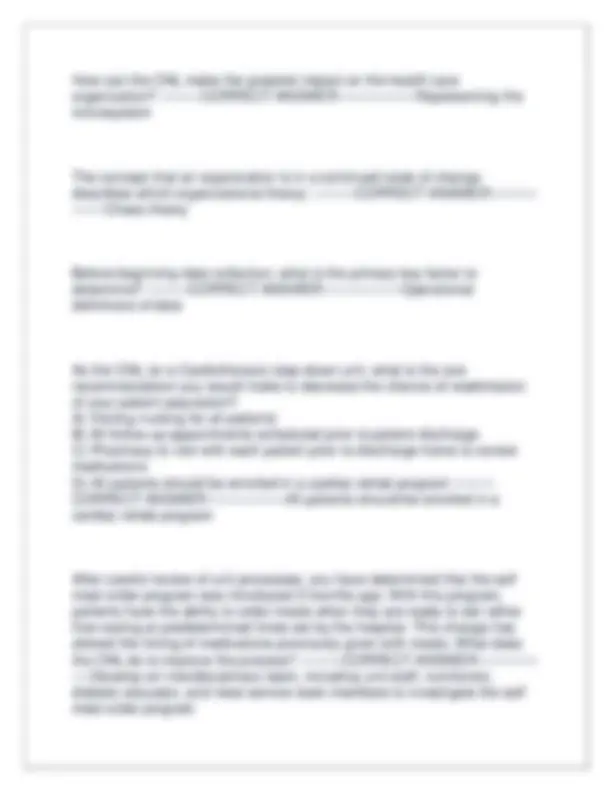
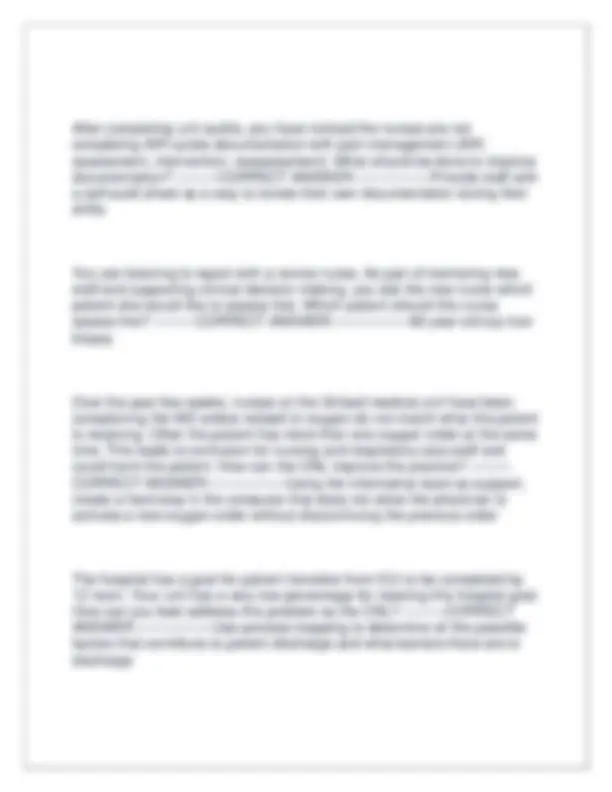
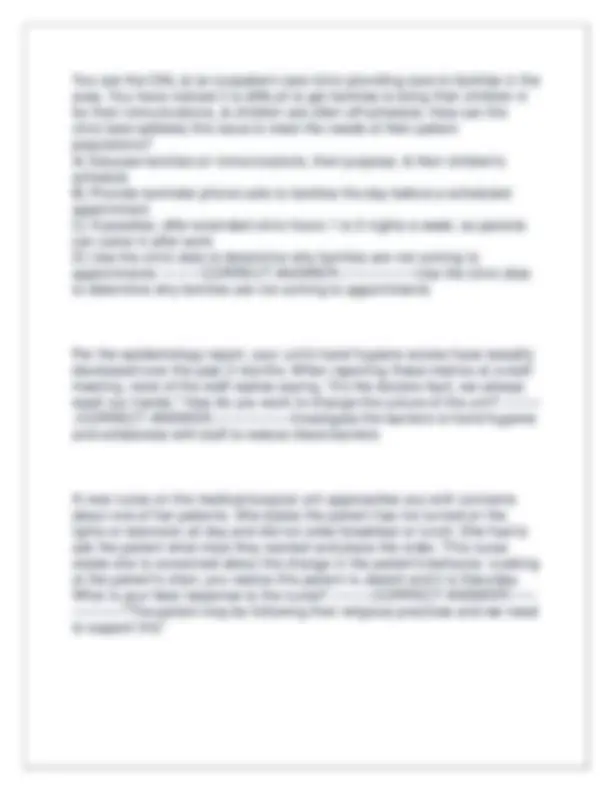
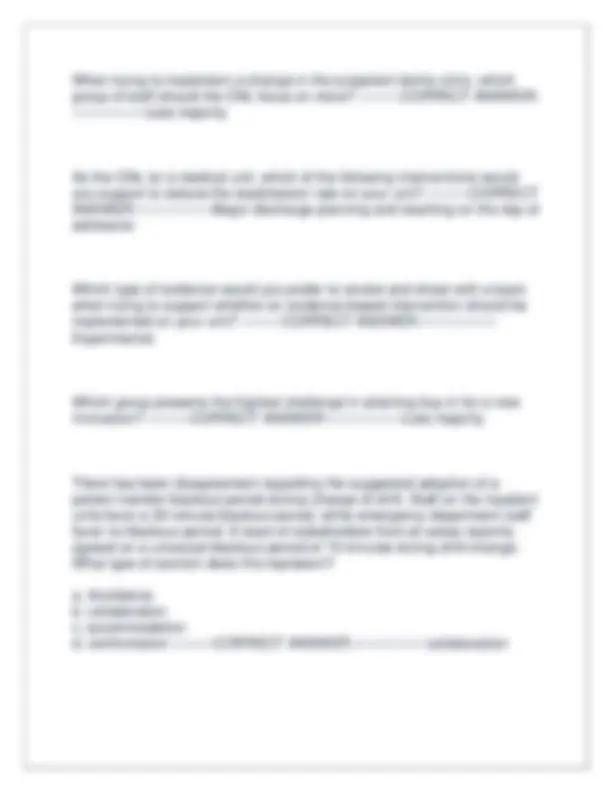
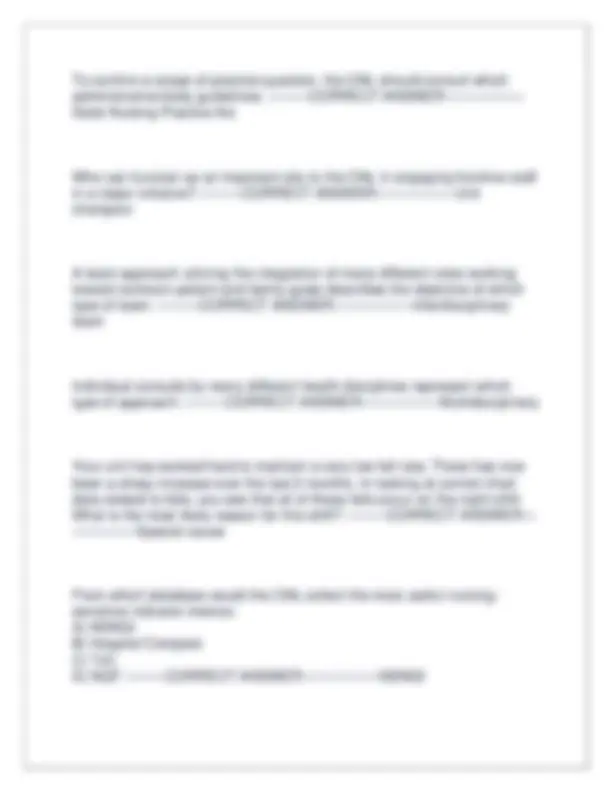
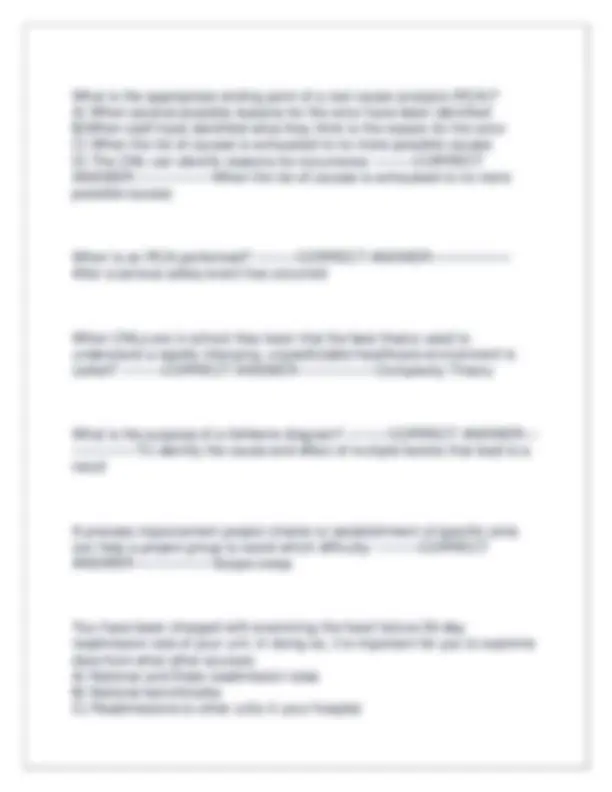
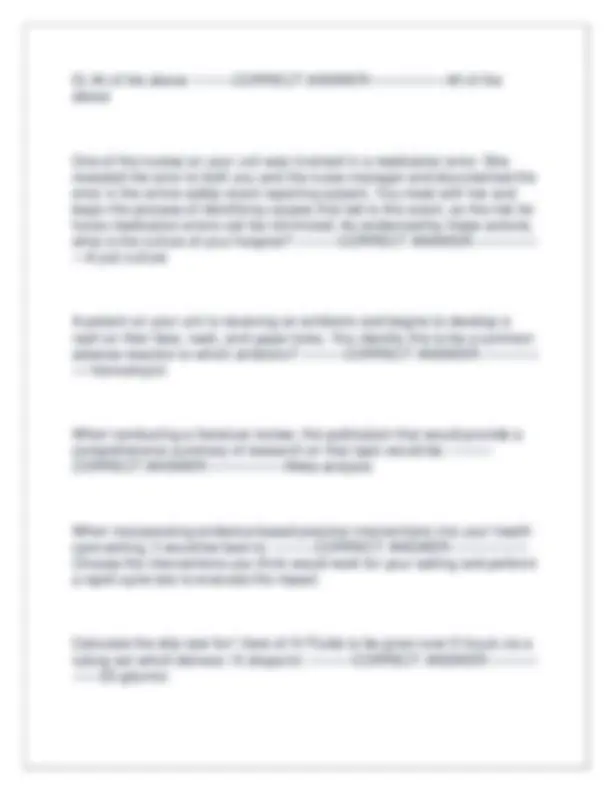
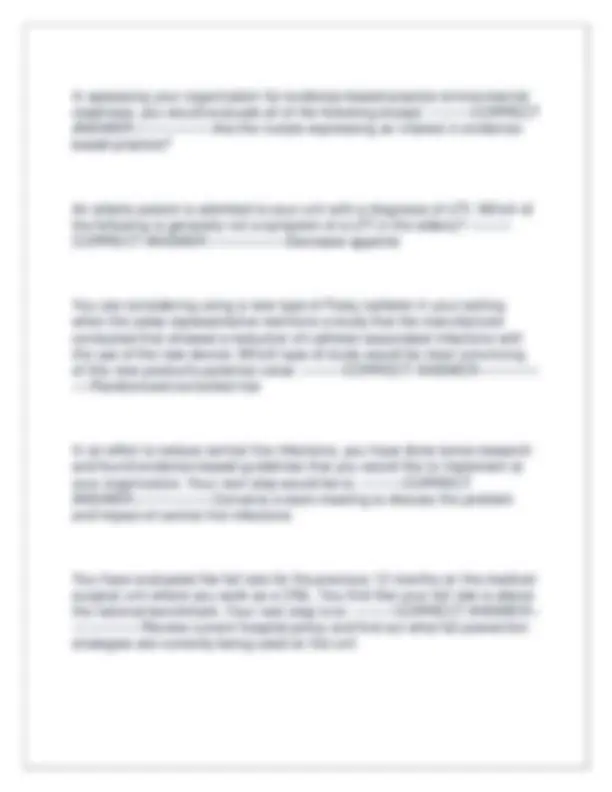
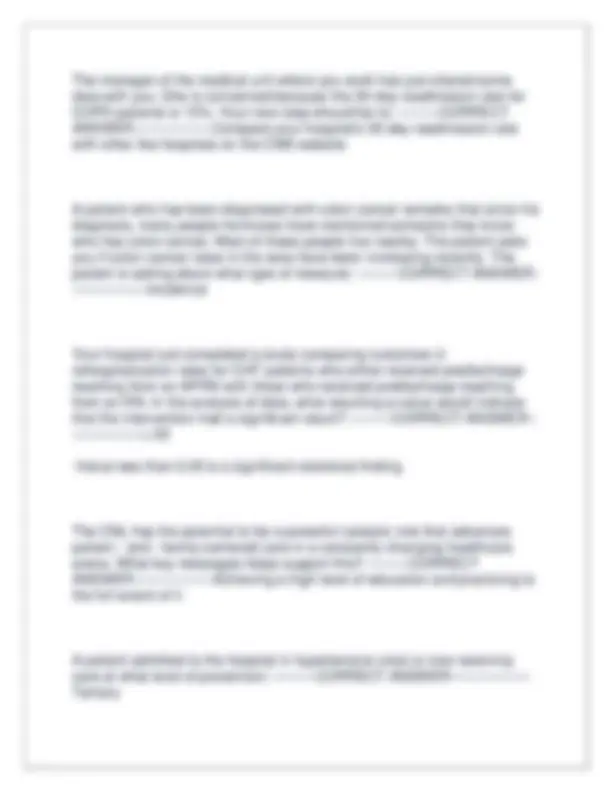
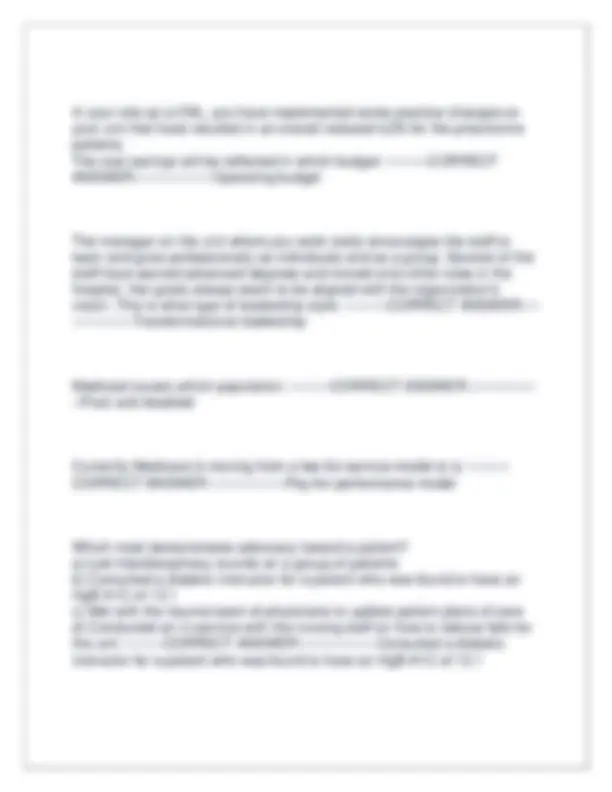
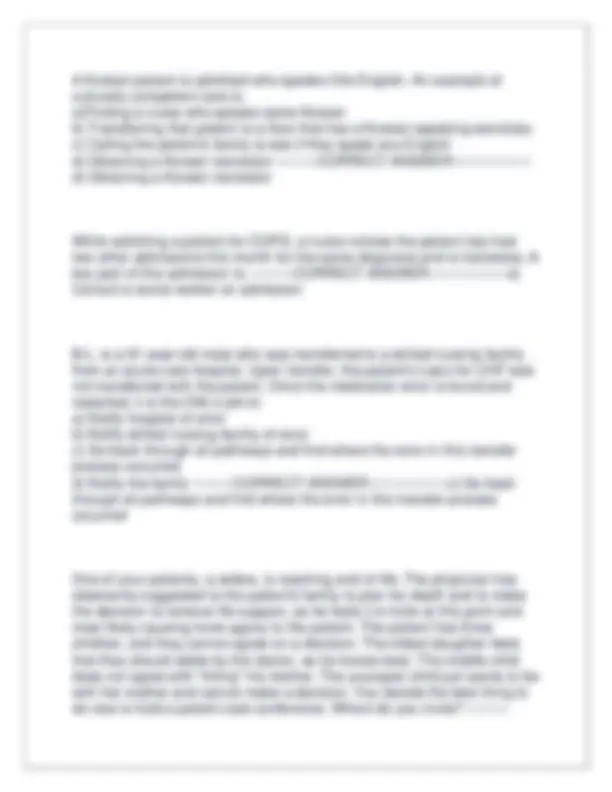
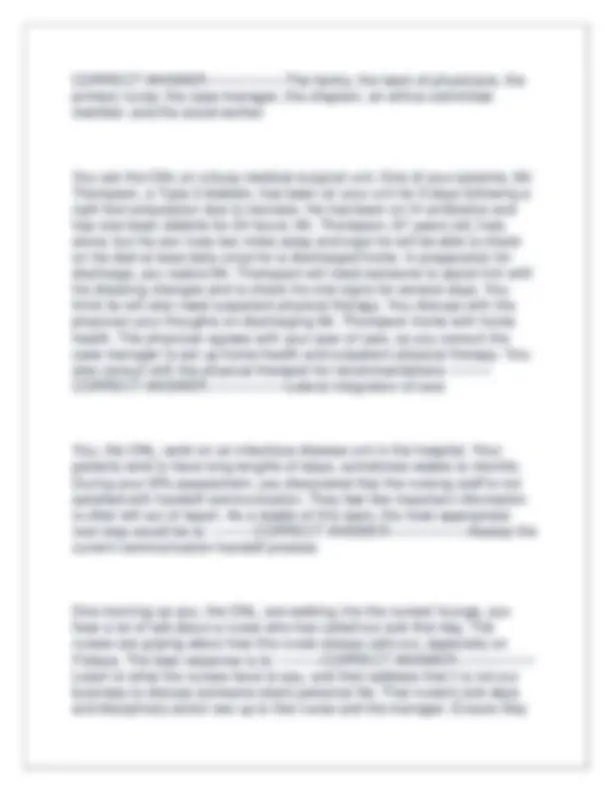
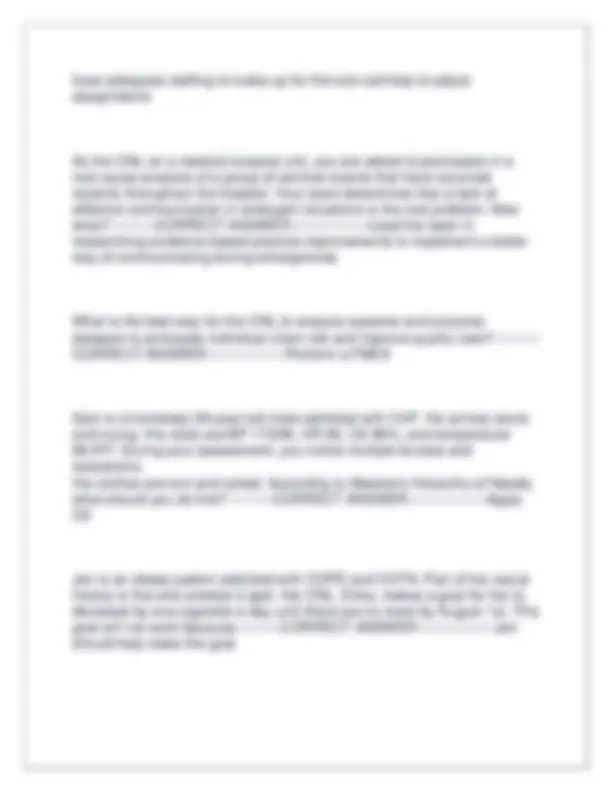
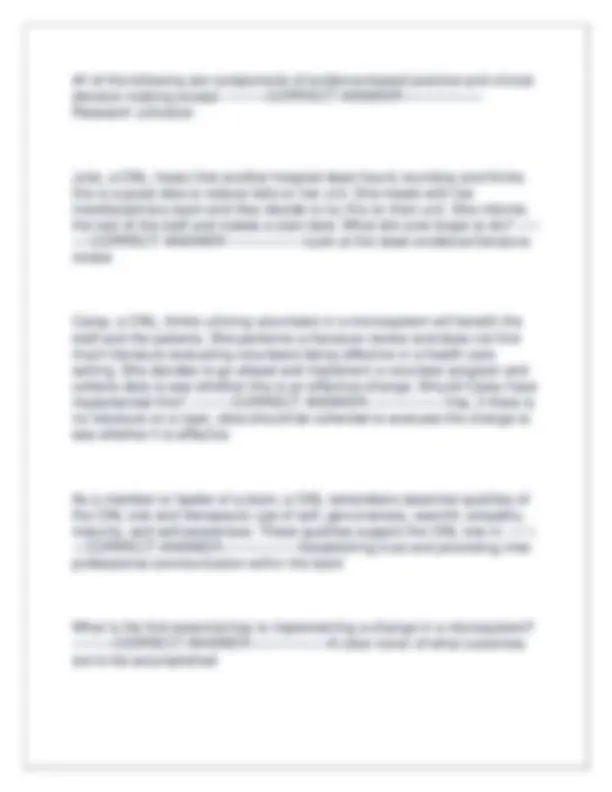
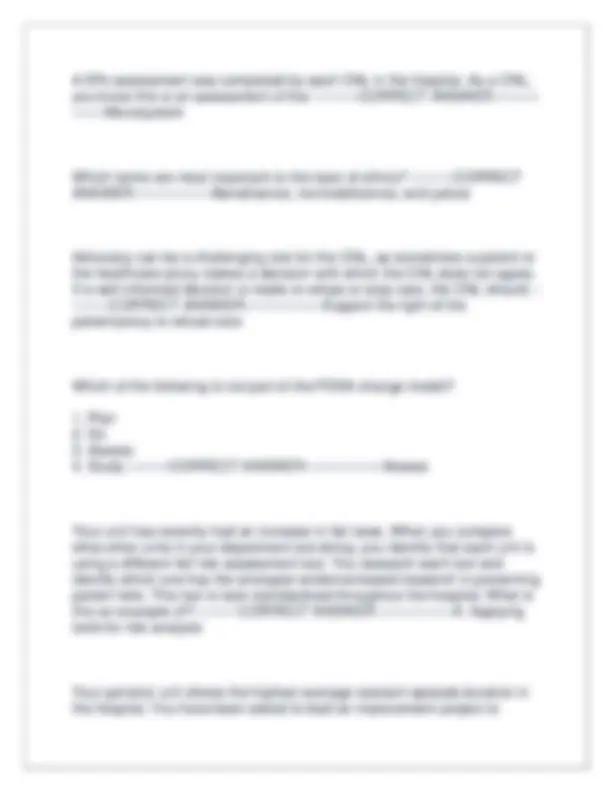
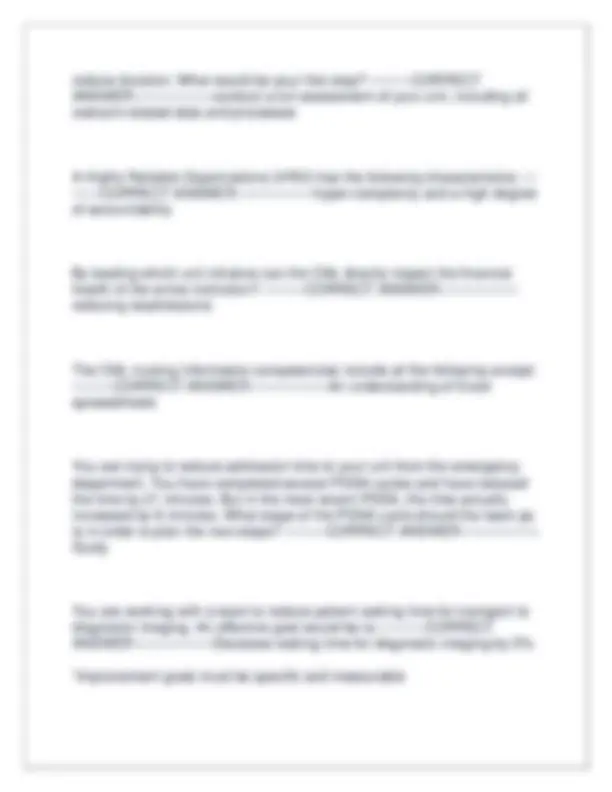
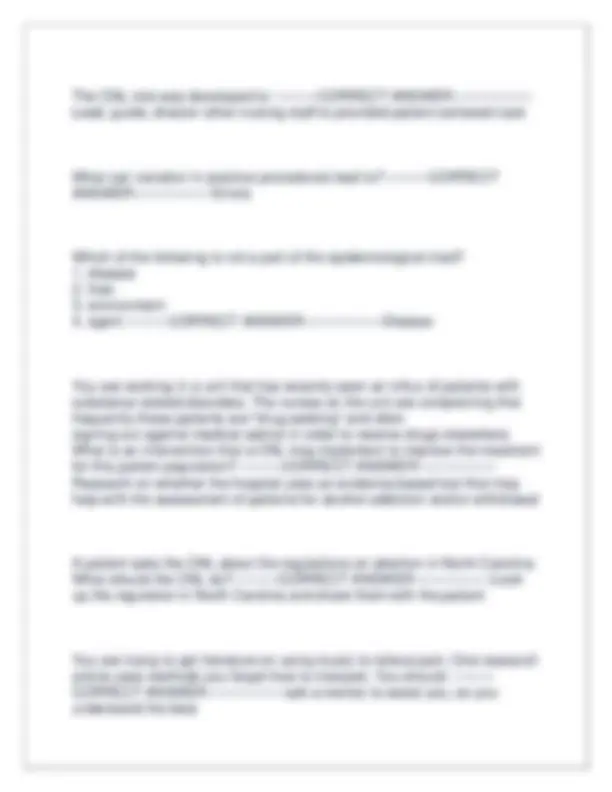
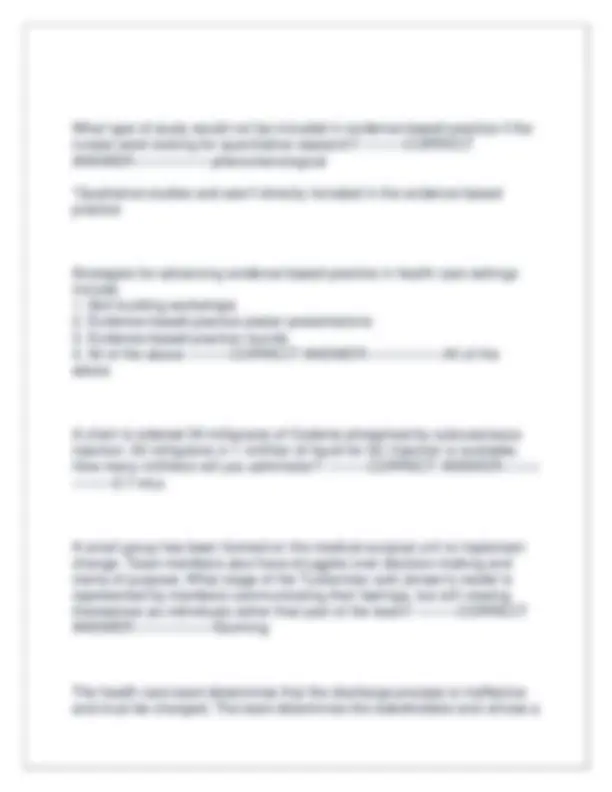
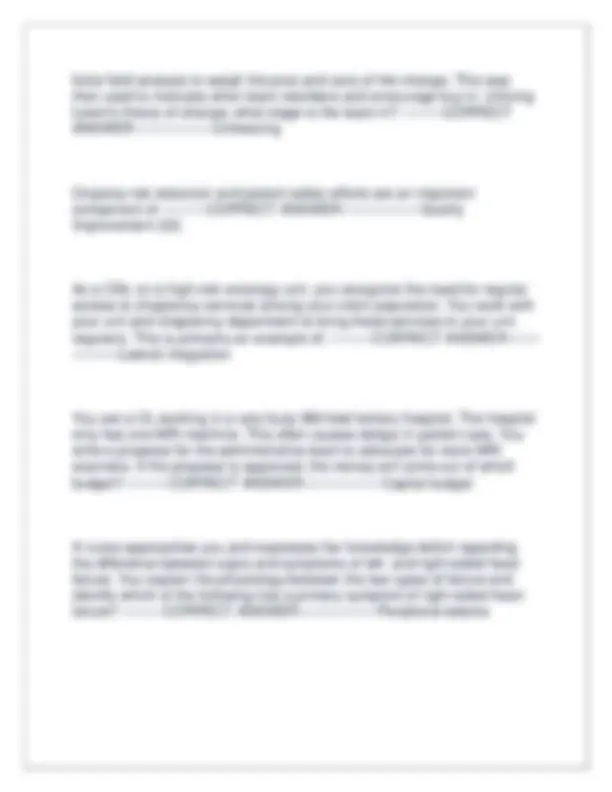


Study with the several resources on Docsity

Earn points by helping other students or get them with a premium plan


Prepare for your exams
Study with the several resources on Docsity

Earn points to download
Earn points by helping other students or get them with a premium plan
Community
Ask the community for help and clear up your study doubts
Discover the best universities in your country according to Docsity users
Free resources
Download our free guides on studying techniques, anxiety management strategies, and thesis advice from Docsity tutors
CNL CLINICAL NURSE LEADER EXAM 2025 | COMPLETE QUESTIONS AND CORRECT ANSWERS WITH RATIONALES | GRADED A+ | VERIFIED ANSWERS | JUST RELEASED
Typology: Exams
1 / 73

This page cannot be seen from the preview
Don't miss anything!


































































Advocacy can be a challenging role for the CNL, as sometimes a patient or the healthcare proxy makes a decision with which the CNL does not agree. If a well informed decision is made to refuse or stop care, the CNL should: A) Try to talk the patient/proxy into continuing treatment. B) Select a trusted religious leader to visit and assist the patient/proxy to change the decision. C) Move the patient to another microsystem because the CNL does not agree with the decision. D) Support the right of the patient/proxy to refuse care. ---------CORRECT ANSWER-----------------D) Support the right of the patient/proxy to refuse care. Rationale: Advocacy includes all nurses and interprofessional team members appropriately communicating the treatment options to the patients and families/proxies. This includes the right to accept, refuse, or terminate treatment, and the team members then providing support once the decision is made. Thus, Option D is the correct answer as the CNL supports the patient/proxy. Options A, B, and C do not reflect advocacy on the part of the CNL. As a CNL, you can advocate for nursing as a profession by doing all of these EXCEPT: A) Participate in nursing education. B) Participate in nursing organizations like American Nurses Association, Sigma Theta Tau, or Clinical Nurse Leader Association. C) Participate in a discussion with the physician about the care of a specific patient. D) Participate in efforts to establish legislation that supports nurses practicing to the full extent of their licensure. ---------CORRECT ANSWER---
--------------C) Participate in a discussion with the physician about the care of a specific patient. Rationale: Participating in care discussions is one of the overall responsibilities of the CNL, and bringing up specific patient concerns can be part of the role of advocating for patients. However, this is not an effective method of advocating for the nursing profession J. R. is a 77-year-old who underwent an MRI of his brain due to new onset confusion. J. R. has a history of lung cancer and the results of the MRI of the brain reveals new nodules indicative of brain metastasis. He tells his daughter that he does not want any future chemotherapy treatments and there is "nothing more to be done!" The daughter feels there should be other options available for her father and wants to meet with the oncologist. With permission from the patient, a meeting was coordinated by the CNL to include the patient, the oncologist, the social worker, the hospitalist, the clergy, and the palliative care nurse. The CNL hopes that organizing a meeting with all disciplines will result in open dialogue concerning several options and goals of care for J. R. The CNL is practicing: A) Care coordination B) As an educator C) As a negotiator for best care D) Patient advocacy ---------CORRECT ANSWER-----------------D) Patient advocacy Rationale: The CNL acts as a patient advocate by facilitating a process where the rights and preferences of the patient are addressed. Advocacy is a key competency for CNLs for all of the following reasons EXCEPT: A) Healthcare continues to become more complex and requires all healthcare team members to constantly increase their knowledge and skills.
D) Avoid bad public relations. ---------CORRECT ANSWER-----------------C) Identify and address health disparities and perceived discrimination in the healthcare system. Rationale: As an advocate the CNL wants to help identify and address health disparity and perceived discrimination, and the best sources of this information are usually community organizations. Relationship building is important within a microsystem for the following reason: A) To make friends with the other staff nurses B) To differentiate the roles of the disciplines within the microsystem and better understand the responsibilities and practice of each C) To understand a hierarchy of practice and responsibilities D) To develop practice strict guidelines and boundaries within the disciplines ---------CORRECT ANSWER-----------------B) To differentiate the roles of the disciplines within the microsystem and better understand the responsibilities and practice of each Rationale: By developing relationships, the staff, including the CNL and other disciplines, will understand each group's practices and responsibilities. They will determine similarities and differences across disciplines. They will learn how each can complement each other to achieve high-quality, safe outcomes. A healthy work environment within a microsystem is important for high- quality, safe, patient-centered care. The CNL assists with creating a healthy work environment by doing the following: A) Bringing donuts every Monday to the @ staff on night shift B) Allowing staff nurses to have 15-minute breaks in the morning and afternoon C) Creating a board for staff to present process issues and new ideas in the microsystem
D) Determining a new staffing grid ---------CORRECT ANSWER----------------
and leading teams. CNLs use what is called lateral integration, not vertical integration. Use of feedback is another piece of the tool kit which promotes effective communication, including verbal and nonverbal communication. Three CNLs each work in a 12-bed microsystem. These three microsystems make up one medical-surgical unit in a large healthcare system. The CNLs have regular meetings to be sure they are providing consistent high-quality care to patients throughout the unit. These meetings also allow the CNLs the opportunity to share information on what they have done in their microsystem to mentor and coach the staff nurses as well as ensuring that ideas they have for potential changes are evidence based and align with the unit, nursing, and healthcare system goals. These CNLs are role models for which type of leadership? A) Horizontal Leadership B) Servant Leadership C) Lateral Integration Leadership D) Team Oriented Leadership ---------CORRECT ANSWER-----------------A) Horizontal Leadership Rationale: The three CNLs are demonstrating Horizontal Leadership, as they are working horizontally across the microsystems and using mentoring and coaching with the staff nurses. Servant leadership is a leadership philosophy in which the main goal of the leader is to serve and share power, while putting the needs of the employees first so they may develop and perform as highly as possible. Team Oriented Leadership is not an official type of leadership, and Lateral Integration is a role of the CNL and not a leadership style. A new graduate nurse, Mary, approaches you and states that she needs help inserting a nasogastric tube (NG). Which of the following is the best response when acting as a horizontal leader? A) Go gather the needed supplies and insert the NG tube yourself as Mary watches.
B) Help Mary find the policy to insert the NG tube and then put the NG tube in as Mary watches. C) Help Mary find the policy and review this with her. Then coach Mary as she inserts the NG tube and provide real-time feedback. D) Find the policy and go over it with Mary. Then advise Mary to ask the charge nurse for assistance with inserting the NG. ---------CORRECT ANSWER-----------------C) Help Mary find the policy and review this with her. Then coach Mary as she inserts the NG tube and provide real-time feedback. Rationale: The CNL acts as a horizontal leader by coaching the new nurse as she performs the task and providing feedback as the task is being completed. A staff nurse was asked to take a patient's weight in order for a physician to calculate the appropriate dose for a new drug. The nurse documented the weight with just a number. It is discovered that the nurse actually documented the weight in pounds instead of kilograms and subsequently the patient was given the incorrect dose of the medication. This resulted in a sentinel event. The CNL for the microsystem creates an interprofessional team to do a root cause analysis. Which type of leadership is the CNL demonstrating? A) Servant Leadership B) Interprofessional Leadership C) Horizontal Leadership D) Team-Based Leadership ---------CORRECT ANSWER-----------------C) Horizontal Leadership Rationale: A root cause analysis is performed whenever a sentinel event occurs. A horizontal leader would develop a team of other disciplines to perform the RCA. You are a CNLL on a urology/transplant floor. Your unit has several new graduate nurses. As a CNL, what is your role in relationship to these new team members? A) Resource to assist with nursing tasks
delivery. Which theory is derived from the chaos model and is used to understand a rapidly changing, unpredictable healthcare environment? A) Change Theory B) Systems Theory C) Unpredictable Theory D) Complexity Theory ---------CORRECT ANSWER-----------------D) Complexity Theory Rationale: Complexity theory is used to understand a rapidly changing, unpredictable healthcare environment. Gina is a CNL at a university health center and she is asked by a new nurse to insert an intravenous (IV) line for him because he is still uncomfortable with this skill. As a horizontal leader, Gina decides that the best action is to: A) Develop a training session to educate new nurses on IV insertions. B) Inform the new nurse that she will help coach him throughout the process of inserting the IV. C) Inform the new nurse that inserting IVs is not her job. D) Inform the new nurse that he will do it this time and seek out a nurse educator for proper IV insertion training. ---------CORRECT ANSWER-------- ---------B) Inform the new nurse that she will help coach him throughout the process of inserting the IV. Rationale: Although CNLs do provide education and training for nurses in their setting, it is not the appropriate time when a patient requires an IV. CNLs do not generally perform the care for staff nurses. As a horizontal leader, the CNL should coach the new nurse throughout the process of inserting the IV, therefore building on the new nurse's skills, confidence, and autonomy. Inserting the IV for the new nurse will not help the new nurse learn this new skill, and waiting for a nurse educator is not the best course of action when it is within the role of the CNL to coach the new nurse through the IV insertion process. Carol is a CNL who works in a cancer center.
She is talking to a group of staff nurses who aspire to be leaders in the future. Carol explains there are numerous types of leadership. Which type of leadership is she describing when she states that the philosophy of this leadership style promotes equality and an open-door policy and allows team members to voice their opinions and to provide feedback freely? A) Transformational leadership B) Horizontal leadership C) Servant leadership D) Vertical leadership ---------CORRECT ANSWER-----------------B) Horizontal leadership Rationale: Horizontal leadership is correct as this is part of the definition. Transformational leadership involves creating a vision to guide individuals to change through inspiration and motivation. Servant leadership is a leadership philosophy in which the main goal of the leader is to serve and share power, while putting the needs of the employees first so they may develop and perform as highly as possible. Vertical leadership is a top-down style of leadership with one person at the top and team members may not be encouraged to question or provide feedback. A staff nurse comes to the CNL about a problem within the microsystem. This problem is that tubing for central lines is not being labeled consistently and according to the unit policy. As a horizontal leader what should the CNL do first? A) Encourage the staff nurse to investigate further and document what the unit trends are and what are possible solutions, while including other staff nurses. B) Bring this observation to the next nursing leadership meeting in the organization to see how other leaders would handle this. C) Create a completely new policy overnight to ensure that labeling of central line tubing is done consistently within the microsystem. D) Go to the unit manager and ask that all staff nurses be mandated to label their tubing according to the current policy ---------CORRECT ANSWER-----------------A) Encourage the staff nurse to investigate further and document what the unit trends are and what are possible solutions, while including other staff nurses.
symptom. Who would be best suited to assume care for Sarah at this point? A) A Sexual Assault Nurse Examiner (SANE) B) LPN with years of experience at the health center C) RN who knows Sarah from previous visits D) An emergency department (ED) physician ---------CORRECT ANSWER- ----------------A) A Sexual Assault Nurse Examiner (SANE) Rationale: While both an RN and an LPN could help with gathering vitals and basic information from the patient, a SANE is trained to gather appropriate information from the patient and properly obtain forensic evidence from the patient. It is unnecessary to transfer the patient to the ED if a SANE is available at the facility. Furthermore, an emergency physician may not be trained for forensic collection. Team-based healthcare involves the delivery of services to: A) Patients and families by a healthcare team member B) Patients, families and communities by at least two healthcare team members C) Communities by one or two healthcare team members D) Patients, families and communities by one healthcare team member ----- ----CORRECT ANSWER-----------------B) Patients, families and communities by at least two healthcare team members Rationale: Option B is the definition of team-based healthcare. It needs at least two team members and may be delivered to patients, families, and/or communities. A CNL takes on a new role at a university health center. The CNL needs to become oriented to this new population and their needs. The CNL discovers Healthy Campus 2020, a spinoff of Healthy People 2020 for colleges. Healthy Campus 2020 is filled with material to address within the student population, such as obesity, sexually transmitted infections, and anxiety.
Through conducting the microsystem assessment, the CNL discovers a free program on campus called Exercise is Medicine. EIM offers free assistance with developing a nutrition and physical activity regimen to the patient's lifestyle. They also help motivate, adjust the nutrition and physical activity plans as the person progresses.What level of prevention is promoting proper nutrition and exercise for patients with obesity? A) Tertiary Prevention B) Primary Prevention C) Secondary Prevention D) Quaternary Prevention ---------CORRECT ANSWER-----------------B) Primary Prevention Rationale: Promoting proper nutrition and exercise for patients with obesity is an example of primary prevention, as this aims to prevent disease processes. Secondary prevention refers to measures done for early detection of disease to initiate effective treatment and decrease/prevent complications. Tertiary prevention reduces the limitations resulting from the diseases. The CNL works on a cardiopulmonary stepdown unit. Within the last two months the CNL has noticed an increase in catheter-associated urinary tract infections (CAUTI) in the unit. During the root cause analysis, an area of opportunity is identified as a nurse-sensitive issue. Which options below include the key individuals the CNL should include on a CAUTI reduction team? A) Clinical nurse manager, quality nurse, staff nurse B) Charge nurse, staff nurse, infection control C) Quality nurse, staff nurse, information technology representation, infection control nurse, physician D) Clinical nurse manager, infection control, executive leadership, information technology representation ---------CORRECT ANSWER----------- ------C) Quality nurse, staff nurse, information technology representation, infection control nurse, physician Rationale: Interprofessional team composition is critical to quality improvement or evidencebased projects. The CNL must identify internal
ambulatory with a steady gait; BP 164/95, RR 24, 02 sat 95% on room air. His HR is 109, and temp 98.4. The patient states that he does have a job but that he sleeps on different friends' couches every night and does not have a permanent residence. He states that he does not have any health insurance. A patient has agreed to enter a drug and alcohol program when he is discharged. Who would be the best person to consult to assist in this matter? A) Chief nursing officer B) Physician C) Clinical case manager D) Pastoral care ---------CORRECT ANSWER-----------------C) Clinical case manager Rationale: The clinical case manager would be the most appropriate person to assist the patient in entering a drug and alcohol program at discharge. The chief nursing officer, physician, and pastoral care are not the best options to assist the patient in this manner. A CNL works on a cardiac surgery unit. Within two months, the CNL has noticed an increase in 30-day readmissions for open heart surgery patients. During a RCA the CNL identifies opportunity around transitions of care and communication with the cardiothoracic surgery ambulatory clinic and home care companies. Which group of stakeholders should the CNL invite to the meeting to brainstorm ways to improve care of patients with indwelling catheters? A) Clinical nurse manager, staff nurse representatives, cardiothoracic surgery attending and advanced practice providers, and case management B) All the staff nurses, the clinic office nurses, and the unit educator C) Unit's social worker, information technology (IT) professional assigned to the unit, and financial advisor D) Home care company management, cardiothoracic surgery advanced practice providers, and clinical nurse manager ---------CORRECT ANSWER-----------------A) Clinical nurse manager, staff nurse representatives, cardiothoracic surgery attending and advanced practice providers, and case management
Rationale: It includes all the key stakeholders related to the issue. You are the CNL assigned to participate in the shared governance "Practice Council" subcommittee in your hospital. The topic is the current process for creating and implementing discharge instructions for patients. In the group, you bring up several discussion questions for the group to consider:
Rationale: Ensuring that medications are affordable will likely affect readmissions the most of all the choices, since the patient will be returning home. The central principles of advocacy include all of the following EXCEPT: A) Protection of the patients' autonomy B) Developing a new interprofessional team C) Advancement and protection of the profession D) Social justice ---------CORRECT ANSWER-----------------B) Developing a new interprofessional team Rationale: Options A, C, and D are all choices that are central principles of advocacy Protecting patient autonomy is a part of the CNL role of advocacy. The CNL does this best by: A) Encouraging the patient to make decisions as quickly as possible, Whether or not the family or interprofessional healthcare team members have had a chance to meet and discuss the options available. B) Completely avoiding situations that may upset the patient with information about the financial implications of illness. C) Continuously informing all family members so that they may make the decisions. D) Considering the patient's cultural beliefs and preferences when planning care. ---------CORRECT ANSWER-----------------D) Considering the patient's cultural beliefs and preferences when planning care. Rationale: Patient autonomy is the ability of an individual to make his or her own decisions and to have self-determination. This means that the patient's preferences and cultural beliefs must be honored as a part of providing care to the patient
Joe is a new CNL on a Bone Marrow Transplant unit. He determined an education platform for frontline staff needed to be revised. He created a team to tackle the process improvement project. Soon after developing the team, Joe is struggling with the team members. Joe realizes that there are a lot of questions and power struggles within the group. What should Joe remember about the stages of change in order to determine which of the following stages the team is experiencing? A) Storming B) Forming C) Norming D) Performing) ---------CORRECT ANSWER-----------------A) Storming Rationale: Storming is a stage where people will push the boundaries. Conflict may occur among members due to personality differences. Team members may experience stress and even fall out of the group. Storming will lead to the next step of norming. Frank is a CNL and has practiced this role for approximately 8 years. Recently, Frank has noticed conflict within the microsystem between the case managers and the CNLs. A particular problem is lack of job/role differentiation. In order to decrease conflict within this microsystem, what is the best option for Frank to take first? A) Assemble all staff for a meeting and hash out the problems. B) Form a committee to work on the roles and responsibilities. C) Write up the responsibilities as he sees them currently. D) Compare the current job descriptions and responsibilities for the CNL and the case manager. ---------CORRECT ANSWER-----------------D) Compare the current job descriptions and responsibilities for the CNL and the case manager. Rationale: One of the defining aspects of the CNL role and practice is that of interprofessional communication and conflict resolution. The first step to resolve conflict is to have a reference to the existing problem. Comparing the current job description and responsibilities is a step in the right direction for change to occur.